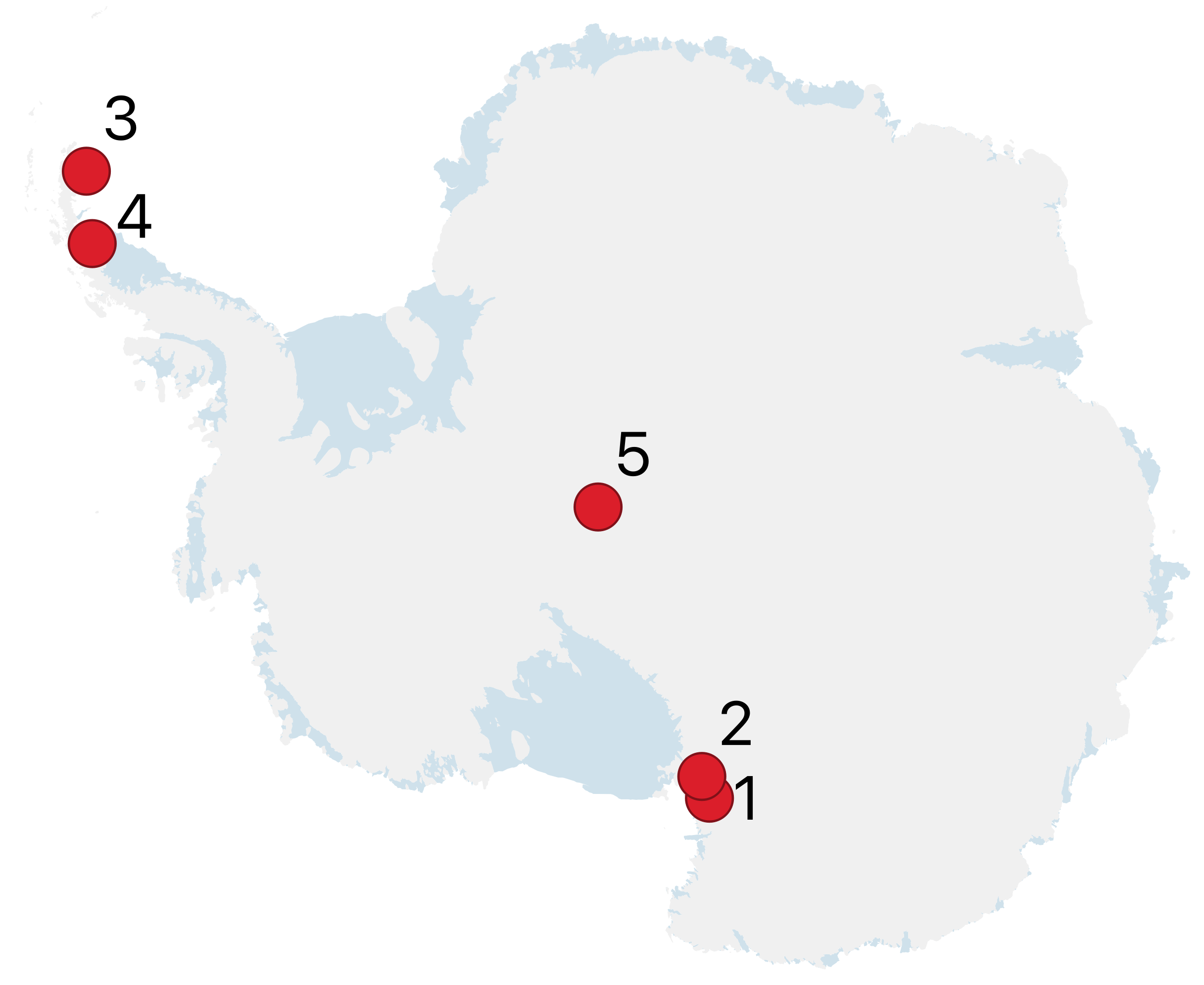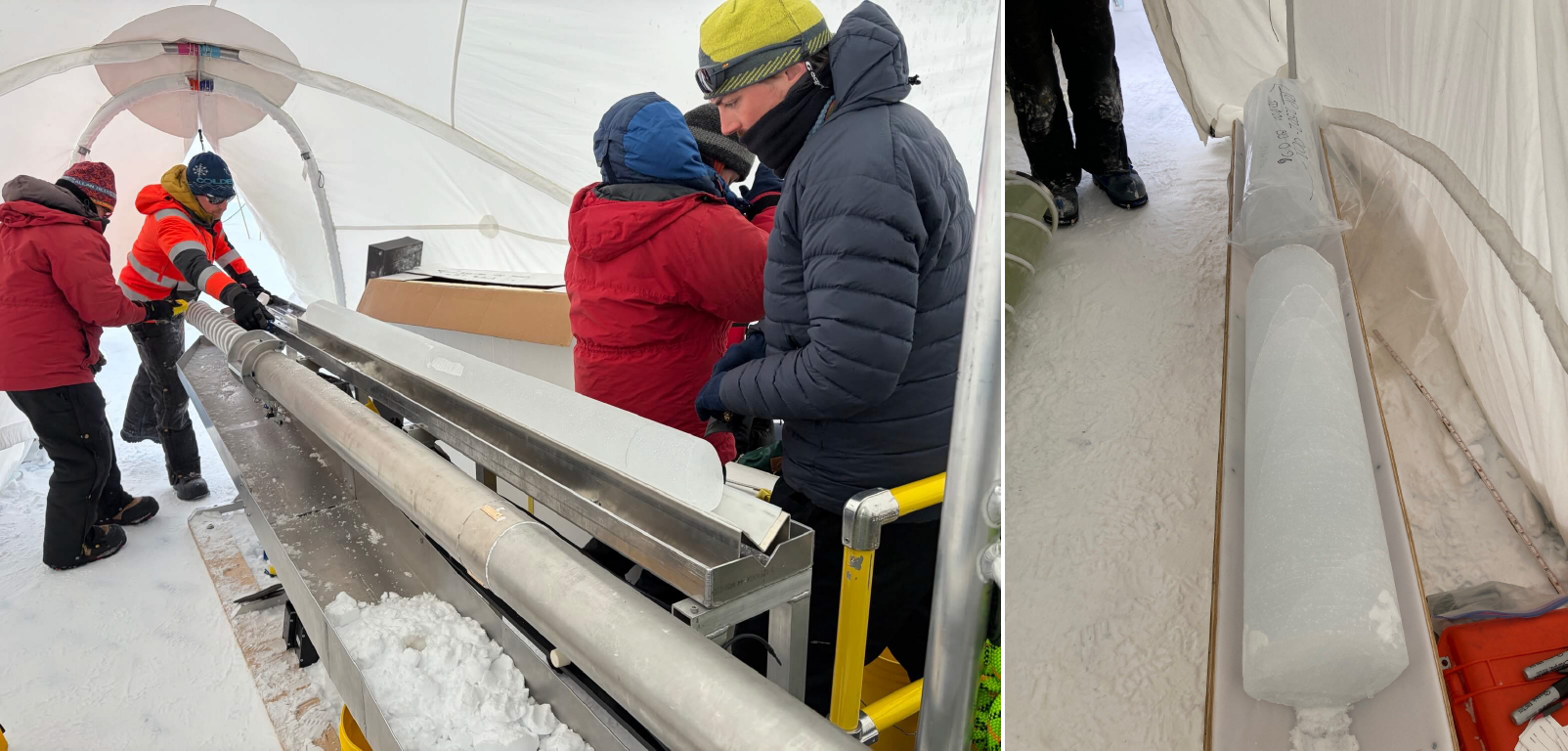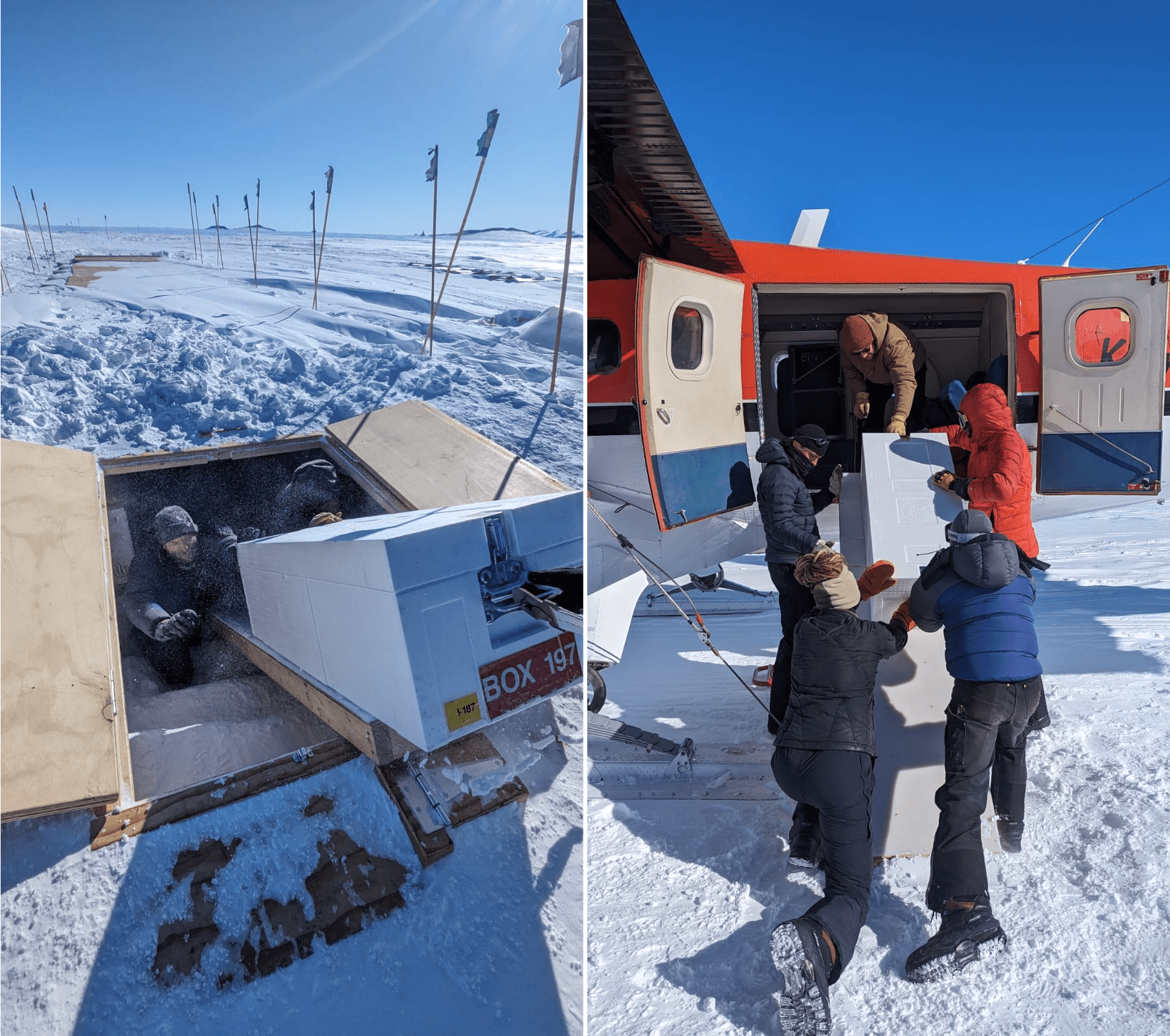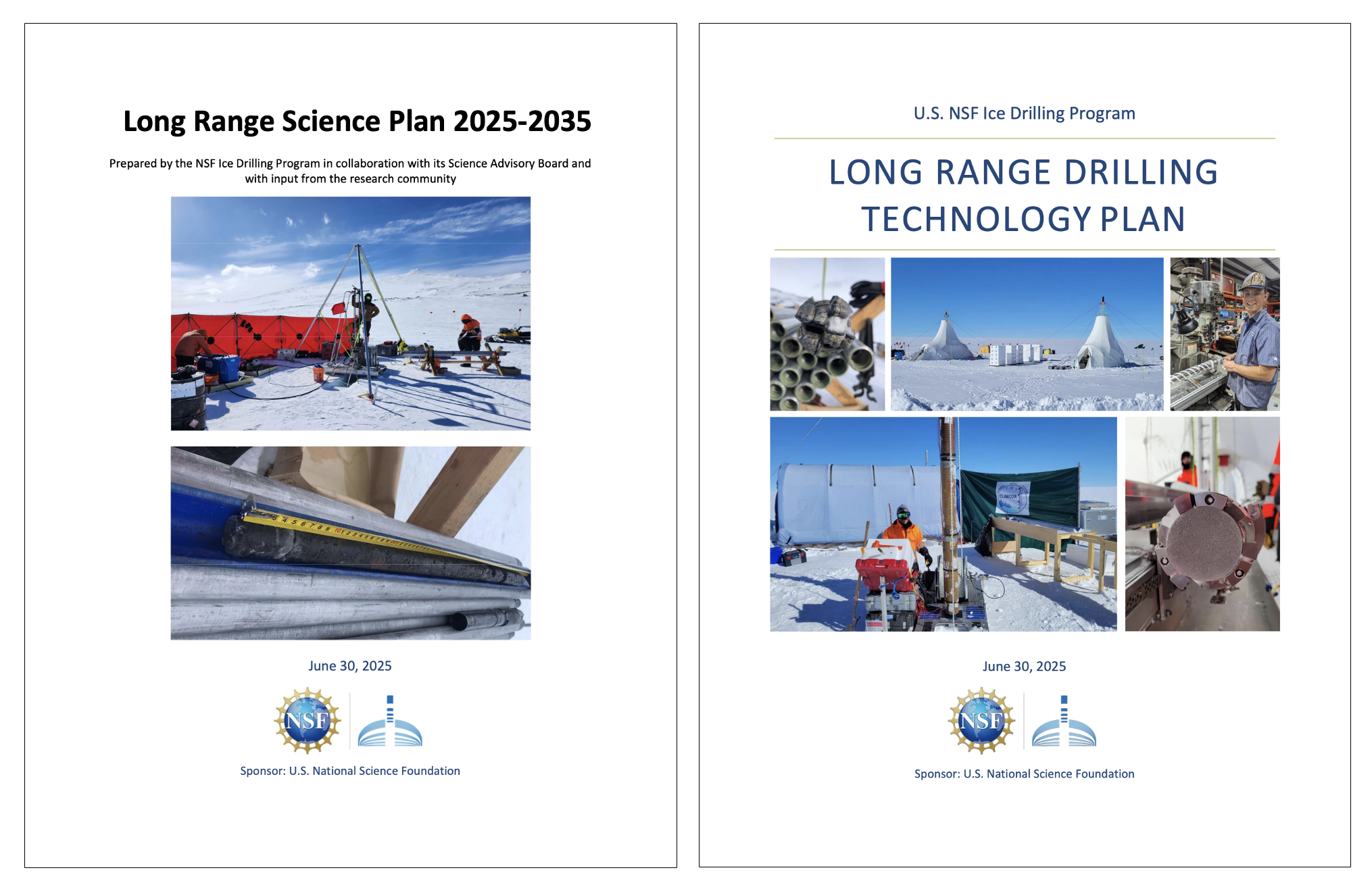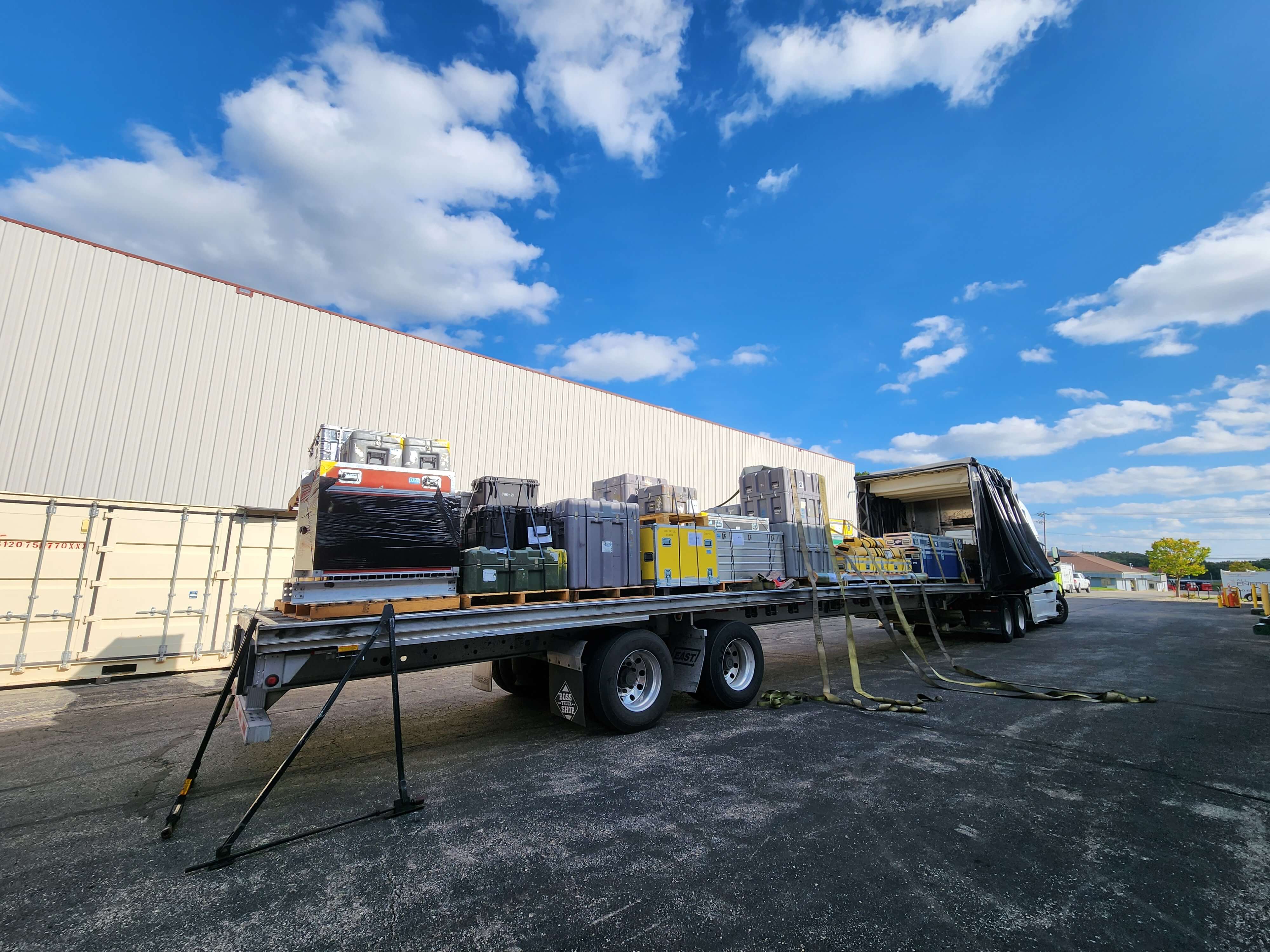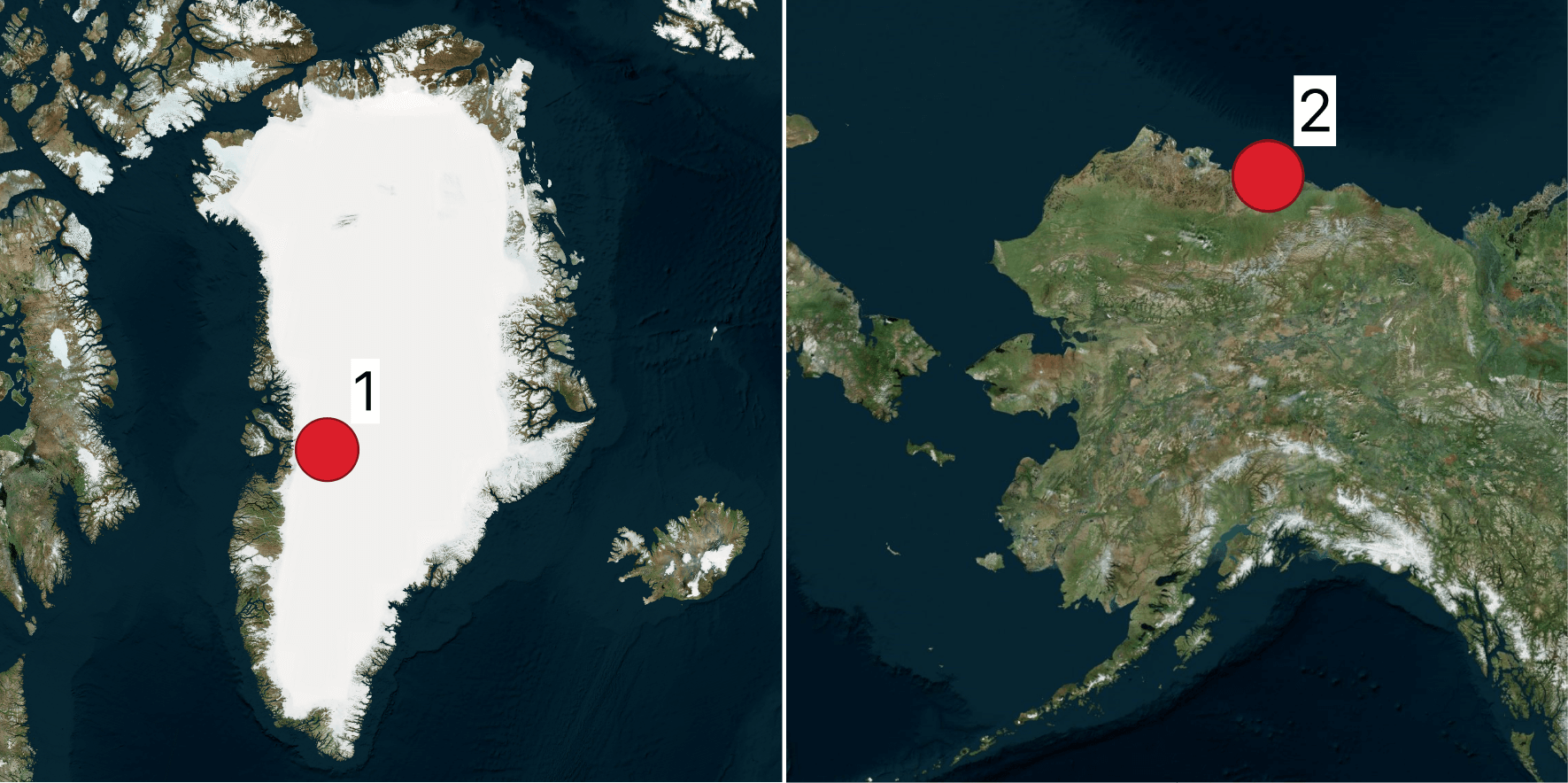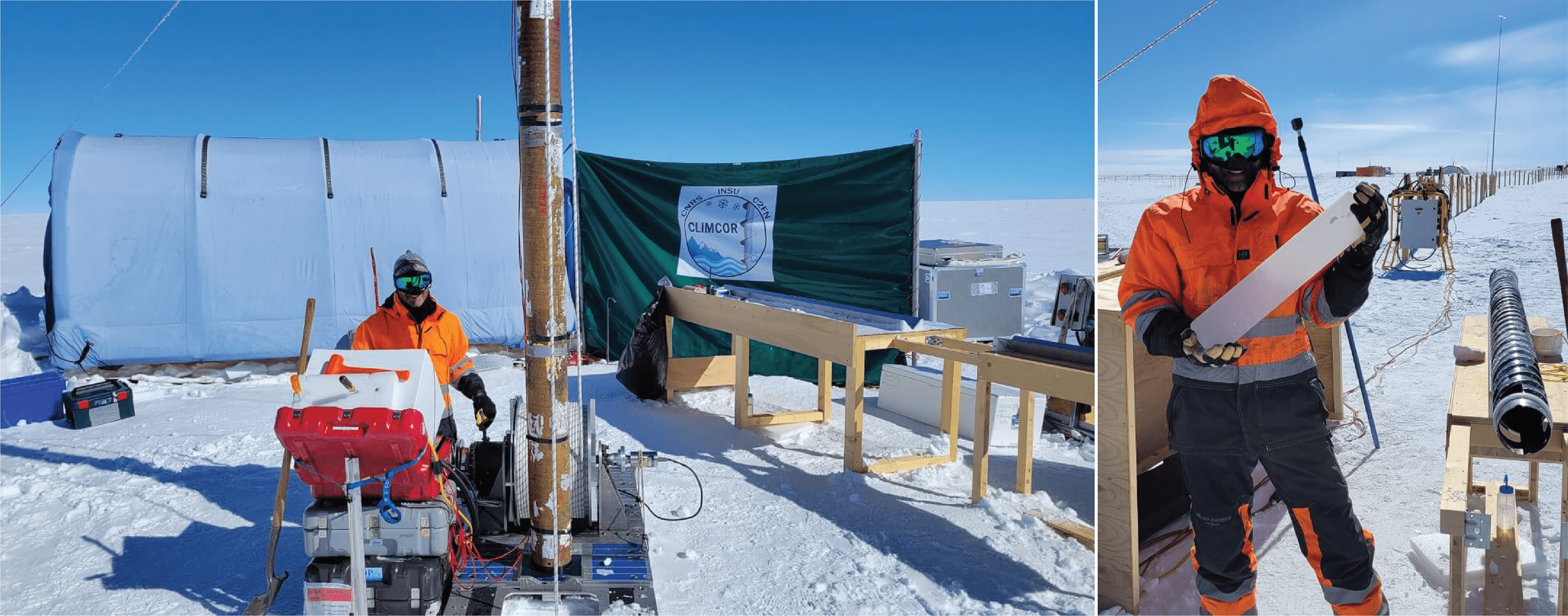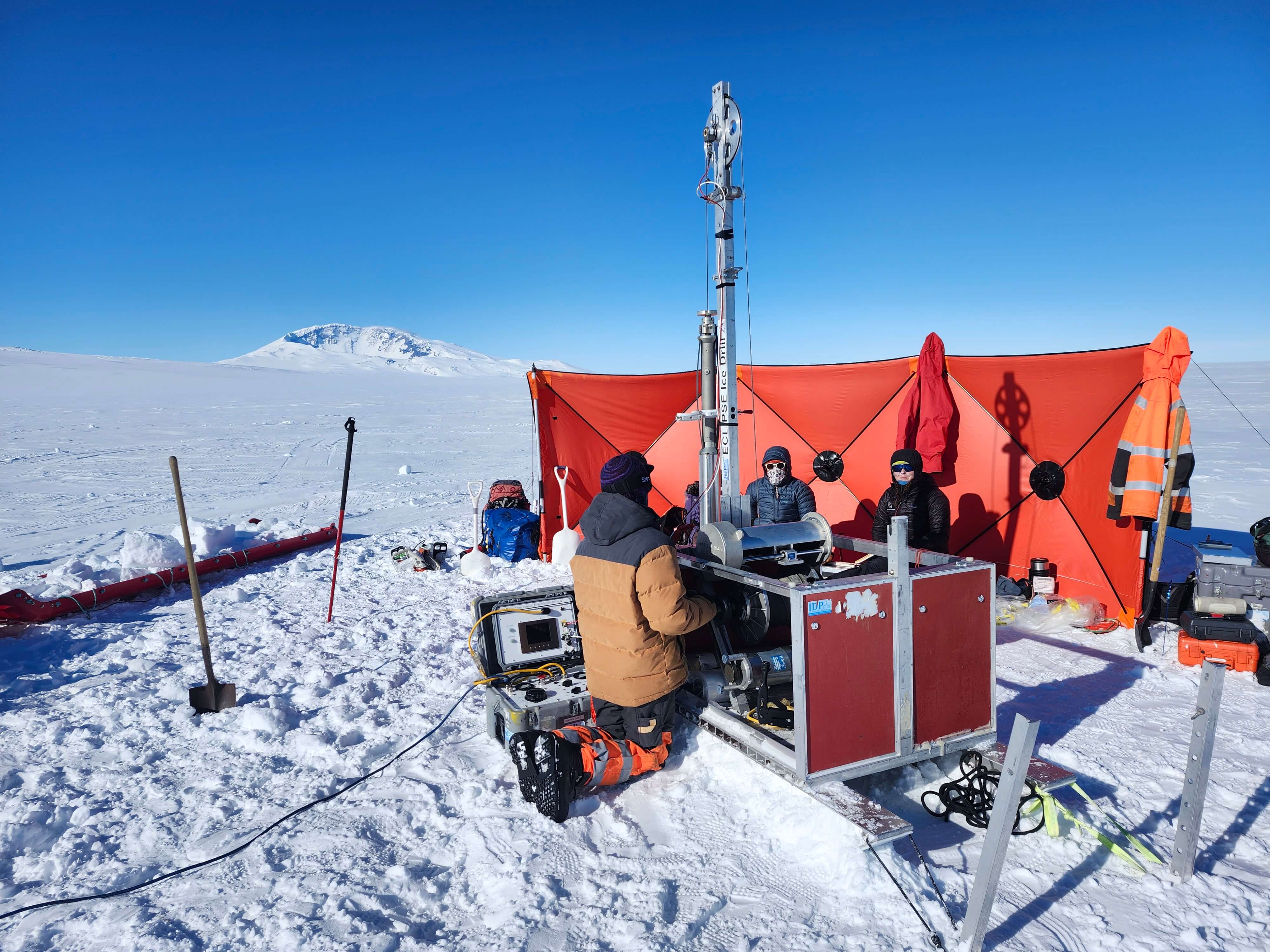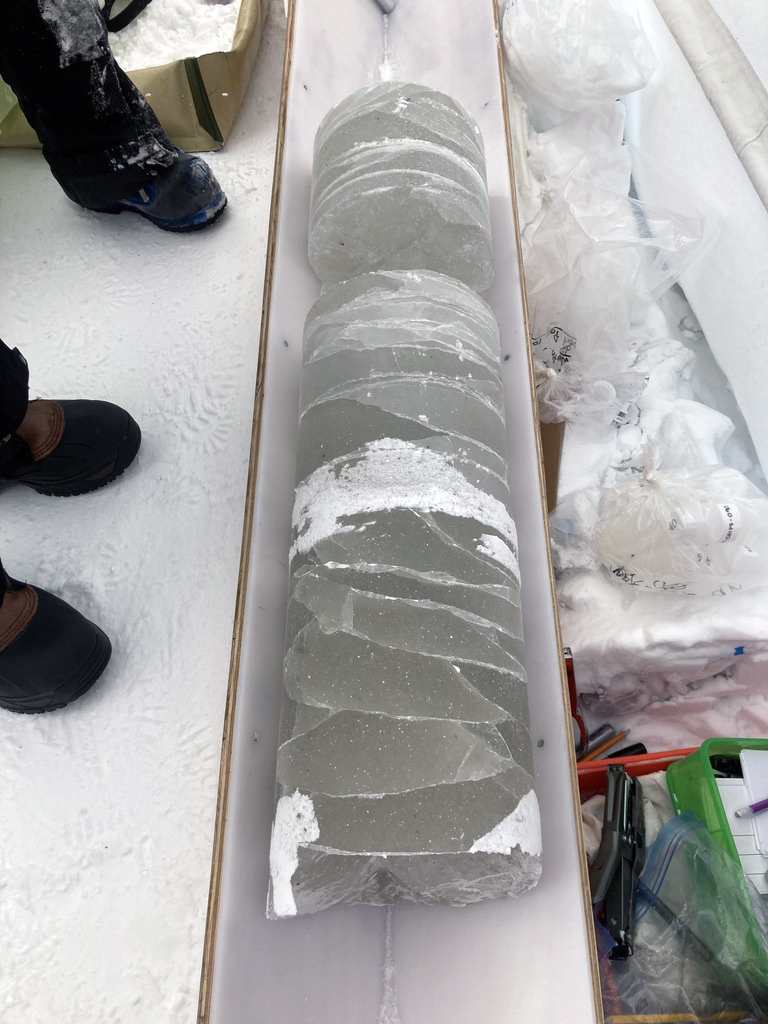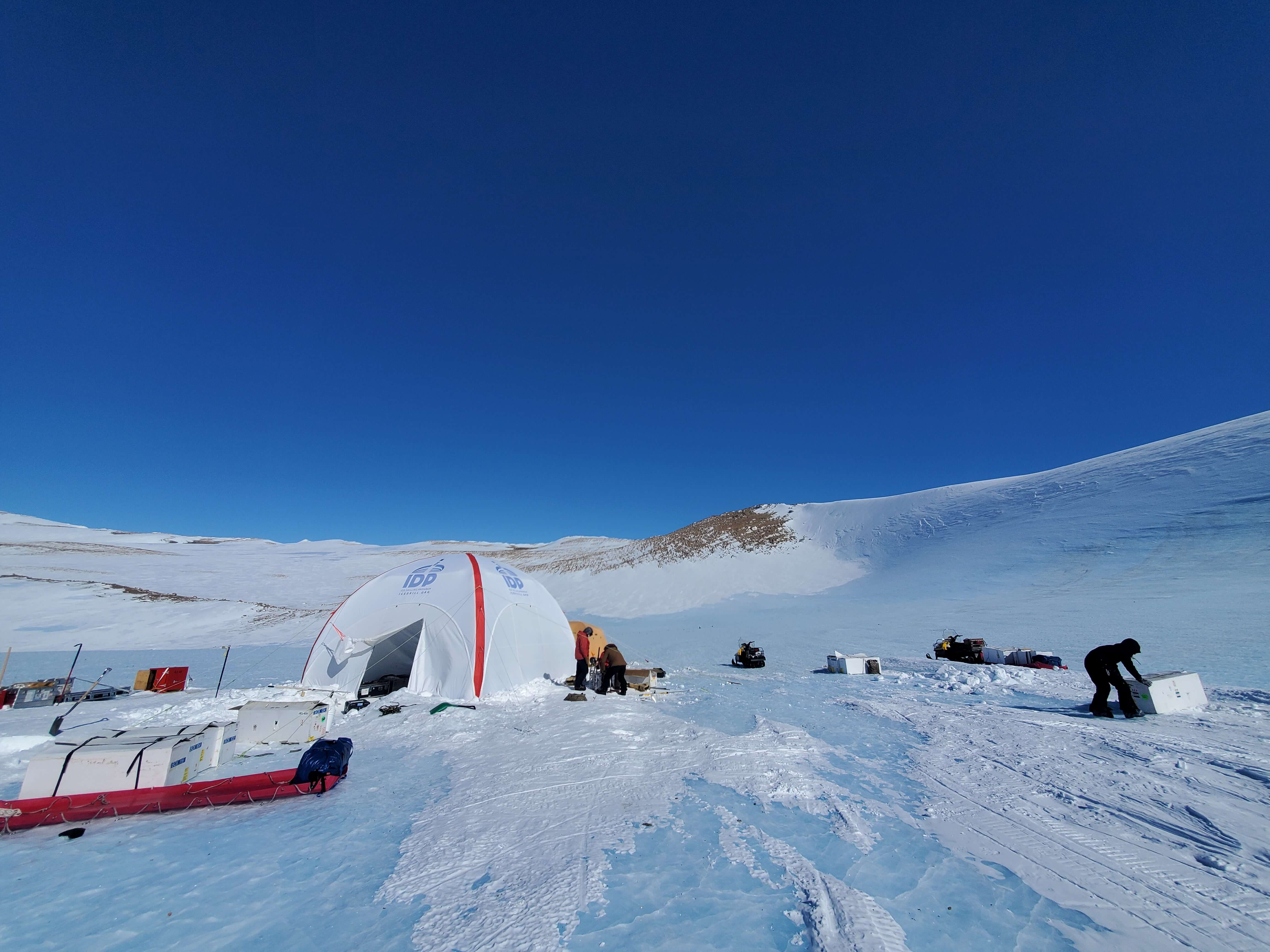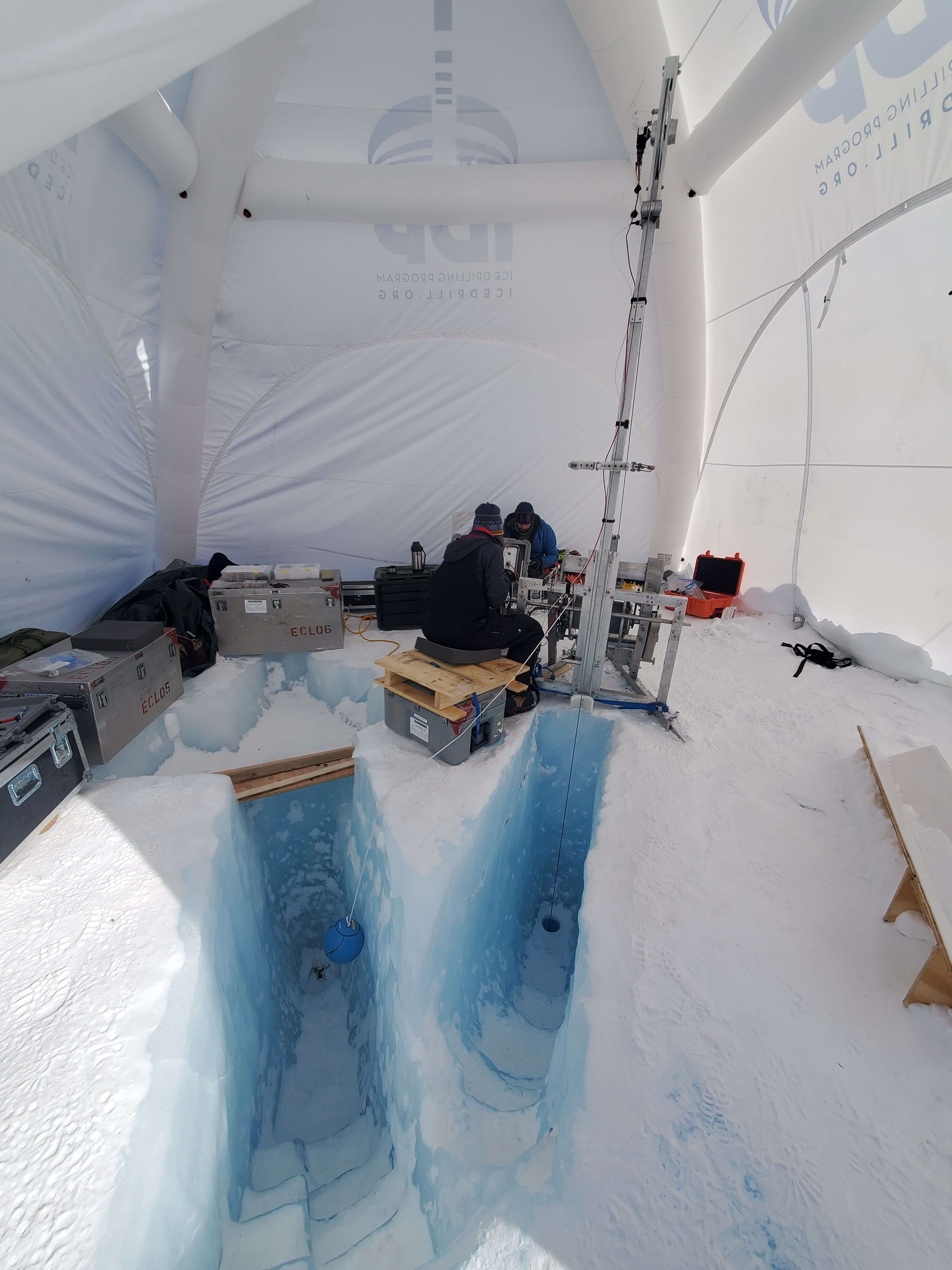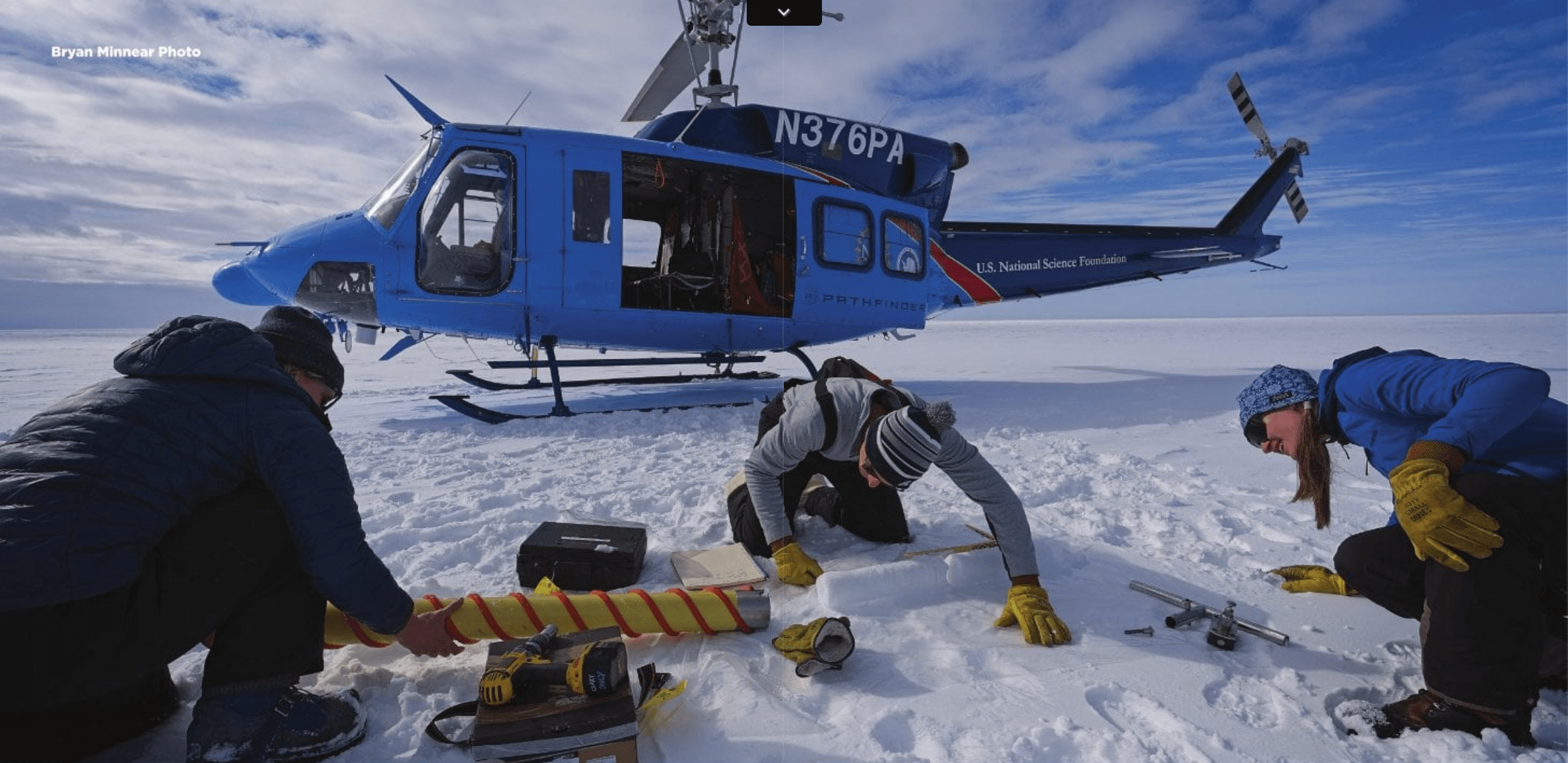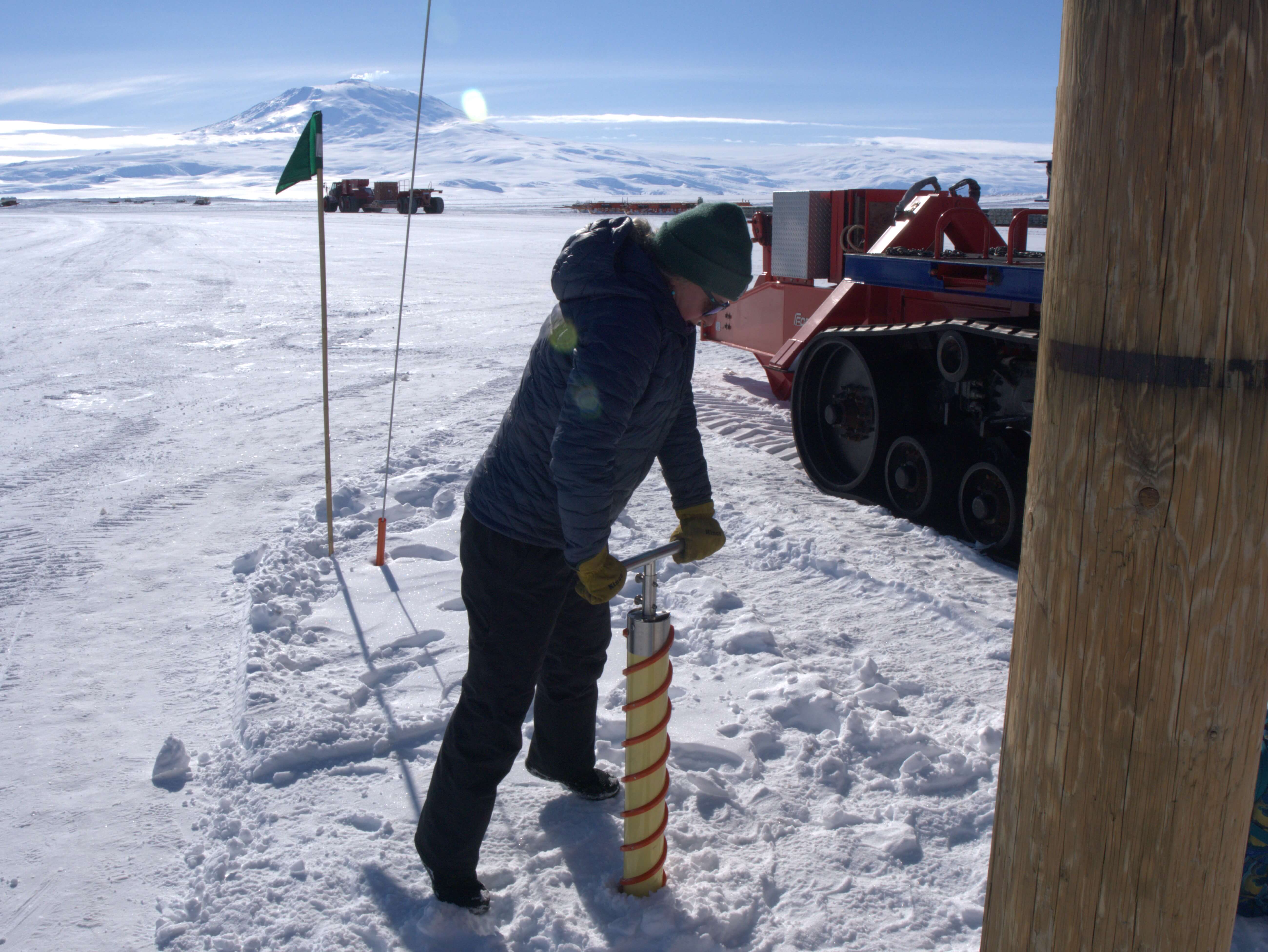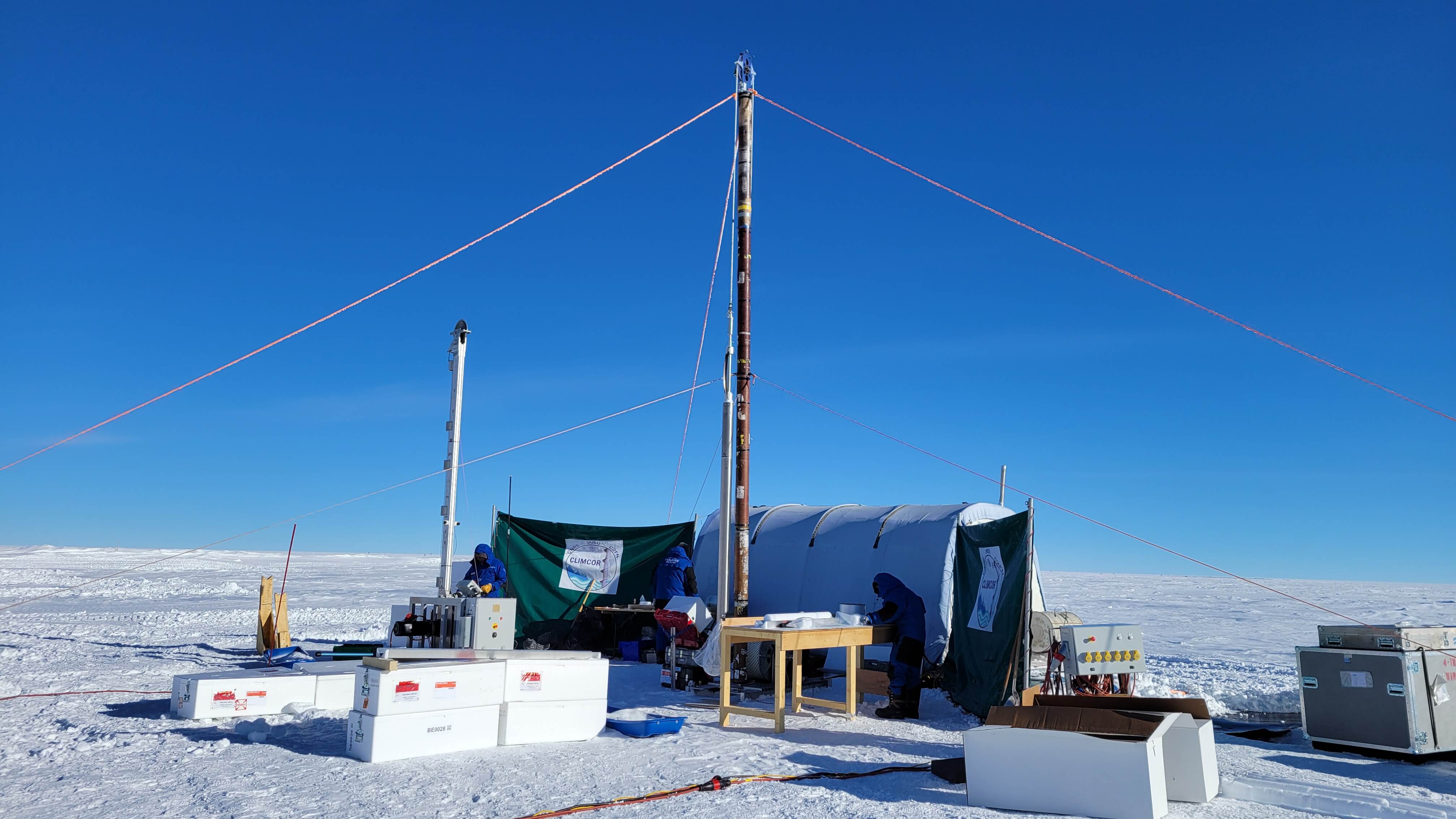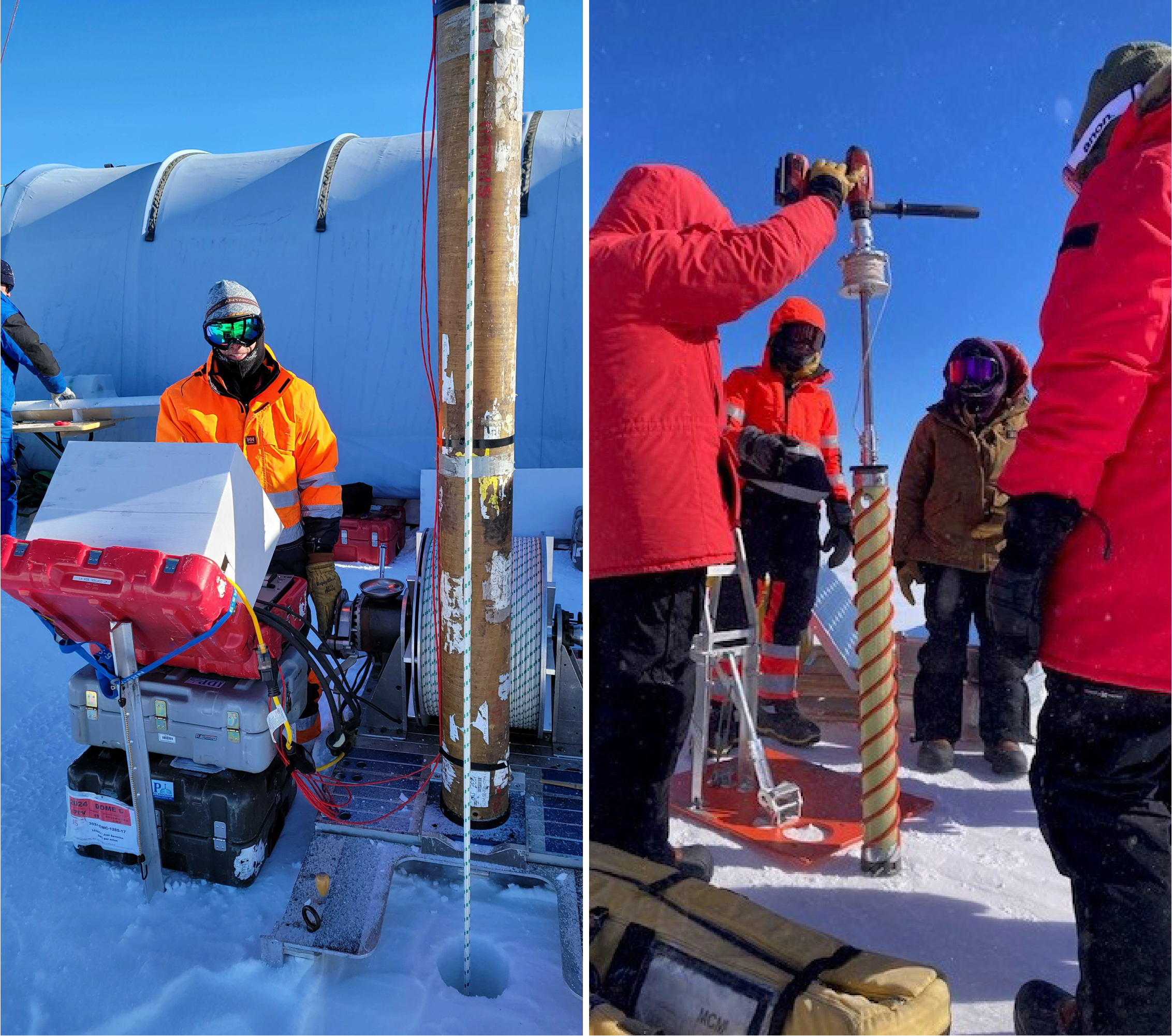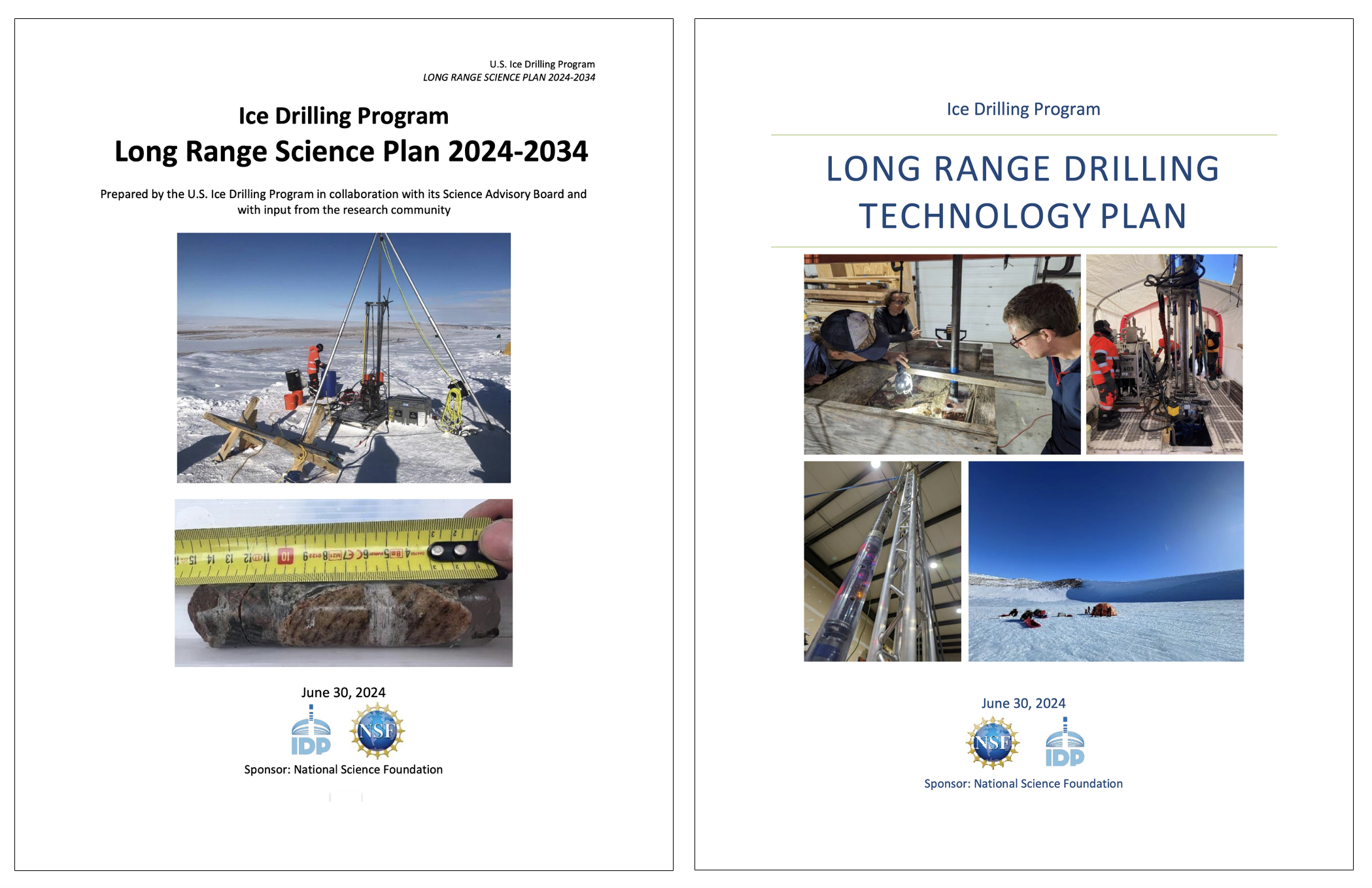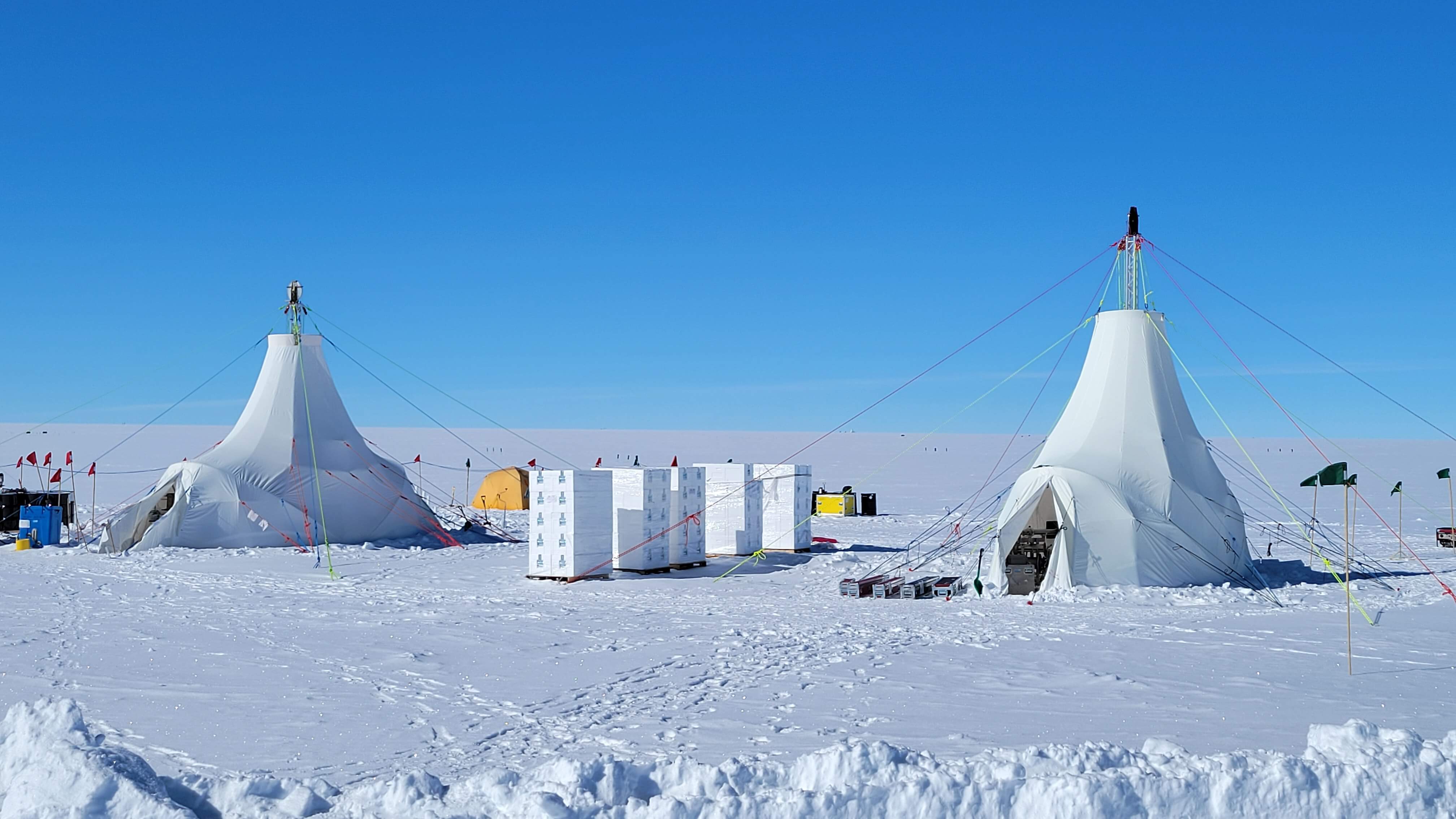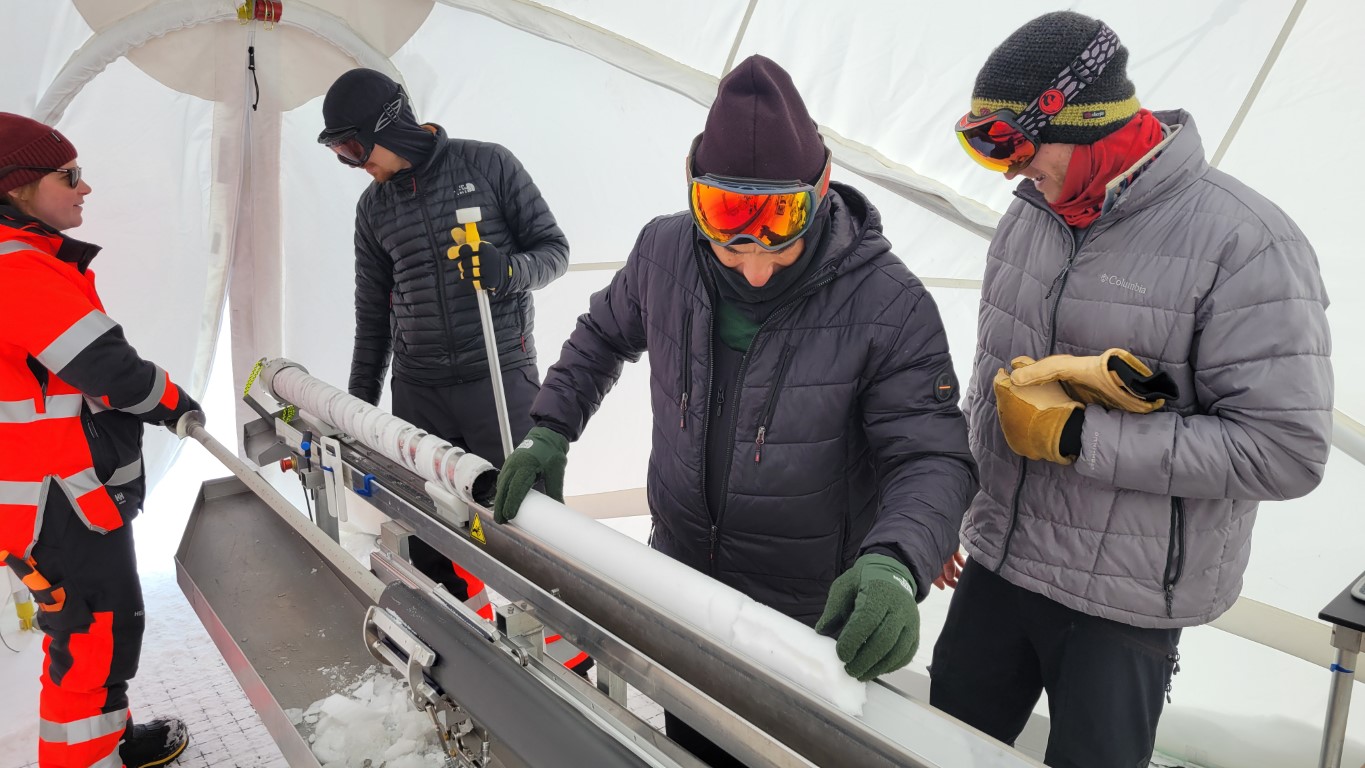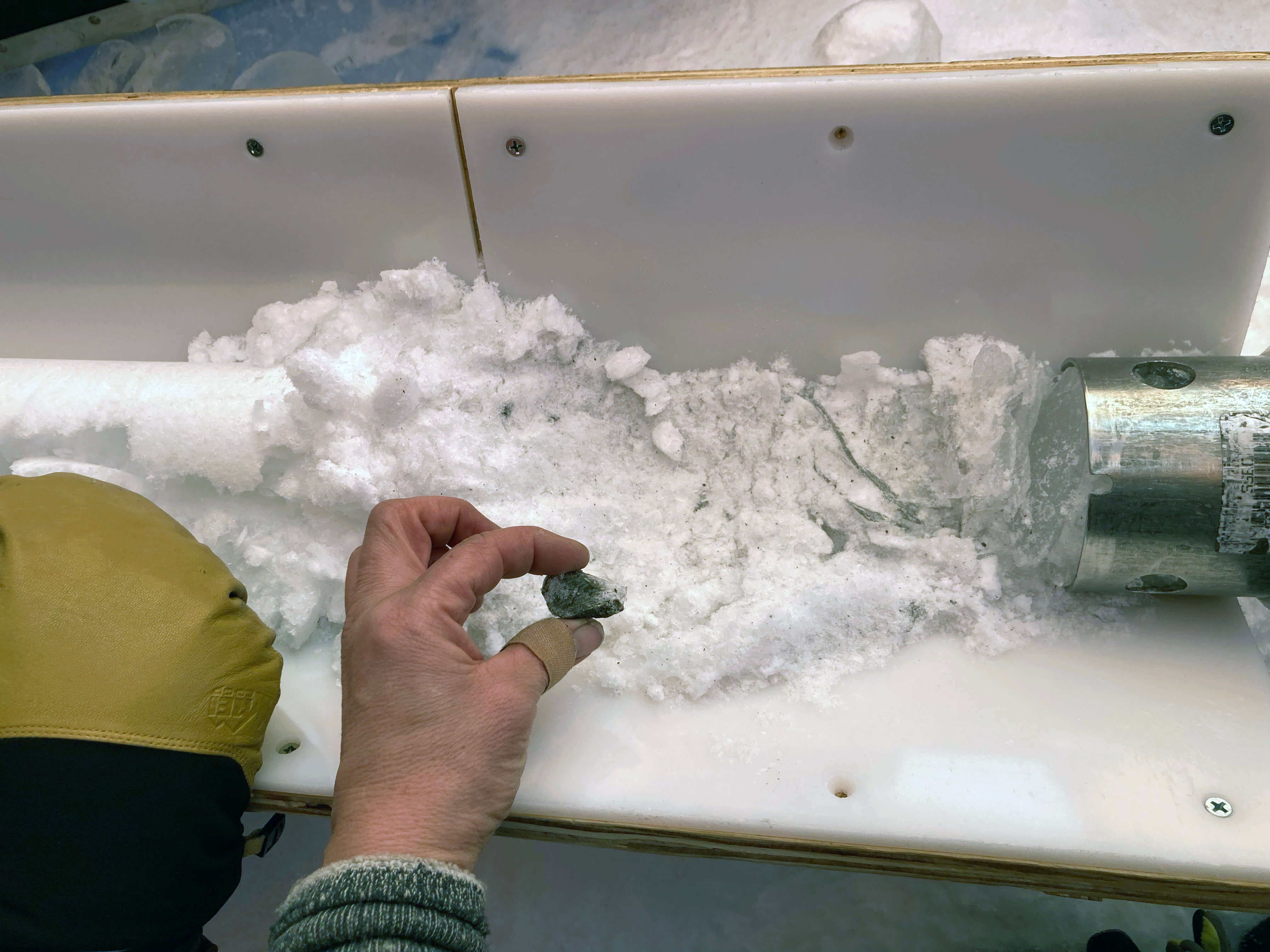On October 31, IDP/SSEC Engineers Jay Johnson, Andrew Haala, Dusty Brunner, and Driller Elizabeth Morton headed south to support the NSF COLDEX project (PIs Sarah Shackleton and John Higgins; I-187-M) at Allan Hills, Antarctica. After a one-day delay in Christchurch (CHC), New Zealand, they arrived at McMurdo Station (MCM), Antarctica, on November 6 and then to Allan Hills on November 18. The team plans to use the large-diameter Blue Ice Drill and a smaller diameter fluid-enabled drill to drill cores at different locations. After a lengthy stay in Christchurch due to weather delays, IDP Engineer Elliot Moravec and Driller Forest Harmon arrived at McMurdo Station on November 29 and are awaiting a flight to Taylor Dome where they will operate the Eclipse Drill and the IDDO Hand Auger and Sidewinder to collect firn cores in support of PI Kaitlin Keegan’s (I-162-M) firn evolution project. IDP Engineer Tanner Kuhl and Jim Koehler are scheduled to deploy to Seymour Island via the R/V Sikuliaq where they will aid in drill site reconnaissance and operate the SIPRE Hand Auger and a PI-provided Shaw Drill in support of PI Thomas Tobin’s (G-296-N) project. At Flask Glacier, PI Jonathan Kingslake’s (I-347-E) team will operate an IDDO Hand Auger to drill several shallow firn cores to investigate the influence of meltwater on Antarctic ice sheet dynamics. And at South Pole Station, PI Albrecht Karl’s IceCube upgrade project (A-334-M/S) will operate the Deep Logging Winch to log one of their newly drilled deep holes with an oriented dust logger.
Fieldwork
IDP Kicks Off Support for the 2025/2026 Antarctic Field Season
Requesting Field Support
If you are preparing a National Science Foundation (NSF) proposal that includes any kind of support from IDP, you must include a Letter of Support from IDP in the proposal. Researchers are asked to provide IDP with a detailed support request six weeks prior to the date the Letter of Support is required. Early submissions are strongly encouraged.
Scientists who seek to include IDP education and outreach activities associated with U.S. ice coring or drilling science projects should contact Louise Huffman at Louise.T.Huffman@Dartmouth.edu during their proposal preparation stage.
For additional information on requesting IDP support, visit our website at https://icedrill.org/requesting-field-support or contact us at IceDrill@Dartmouth.edu.
2025-2035 Long Range Science and Long Range Drilling Technology Plans Updated
The NSF Ice Drilling Program (IDP), in collaboration with its Science Advisory Board and with input from the research community, updated the Long Range Science Plan. This plan aims to articulate goals and make recommendations for the direction of U.S. ice coring and drilling science across a wide variety of areas of scientific inquiry and to provide recommendations for the development of drilling technology, infrastructure, and logistical support necessary to enable the science. A companion document, the Long Range Drilling Technology Plan, provides details about drills available through IDP. Both plans are revisited and revised as appropriate each spring. The Long Range Science Plan is available at https://icedrill.org/long-range-science-plan. The Long Range Drilling Technology Plan is available at https://icedrill.org/long-range-drilling-technology-plan.
If you envision the need for ice drilling for your project in the coming decade, please make sure that the high-level articulation of your science is captured in the Long Range Science Plan. If it isn’t, send several sentences to IceDrill@Dartmouth.edu describing the science driver and the envisioned field date and location for your project so that your plans are voiced in this planning document.
Arctic Field Season Update
IDP provided field support for two projects during the 2025 spring/summer field season. PIs Joel Harper and Toby Meierbachtol (NSF award numbers 2113391 and 2113392) used an IDDO Hand Auger and Sidewinder at several locations in southwest Greenland for their research, which has established a network of instrumented sites to observe the transformation of the Greenland Ice Sheet’s percolation zone firn layer. Harper’s team utilized the redesigned Sidewinder-V2 (version 2), reporting that it worked very well, is small and lightweight for helicopter transport, and is a game changer in those regards. And in Alaska, PI Christian Andresen (NSF award number 2239038) used a SIPRE Hand Auger for research that aims to characterize the role of Arctic wetland ponds in regional land-atmosphere carbon exchange, estimate the ponds' contributions of methane to the atmosphere, and assess how they have changed over the past 50 years to better anticipate their future role in Arctic carbon cycling.
IDP Gears Up for the Antarctic Season
Over the summer, the IDP team worked to repair and maintain several drill systems, many of which will be deployed during the upcoming 2025/26 Antarctic field season. A penetration drive and a load cell were added to the Blue Ice Drill to provide the operators with finer control and more feedback, and a new steel core barrel was fabricated, along with large quantities of carbide cutter inserts. These modifications are an effort to improve core quality in the challenging ice conditions encountered at Allan Hills and beyond. The team also worked to develop the Shallow Wet Drill, which is not a new, standalone drill per se, but features the combining of several components from existing drills in inventory (e.g. Foro 400 anti-torque sections, Foro 1650 motor sections, 700 Drill winch/tower/tent, etc.) with new core barrel components to assemble a drill for testing shallow wet drilling operations at Allan Hills. IDP also designed and is fabricating several tower lifting fixtures to increase safety during the field operation of raising drill towers. IDP anticipates deploying 8 team members for the upcoming field season. In early September, 26 pallets and 16,000+ pounds of equipment departed Madison for Port Hueneme, CA, where it will travel to either Christchurch, New Zealand, or Punta Arenas, Chile, via ship.
2025 Spring/Summer Fieldwork
(1) The Collaborative Research: AON Network for Observing Transformation of the Greenland Ice Sheet Firn Layer project (PIs Joel Harper and Toby Meierbachtol; NSF award numbers 2113391 and 2113392) will establish a network of instrumented sites to observe the transformation of the Greenland Ice sheet’s percolation zone firn layer. Using the IDDO Hand Auger and Sidewinder, repeat cores are being collected over five years to track density and ice content changes, and instrumentation installed in boreholes will monitor firn temperature evolution and compaction of the firn layer. The data from these efforts will be of high value to scientists focused on changes in storage capacity of the firn layer, process details of meltwater infiltration in cold firn, and the influence of firn compaction and melt on satellite-observed ice sheet elevation.
(2) The CAREER: Characterizing Feedbacks in Arctic Ponds while Incorporating Next-Generation Technologies and Arctic Field Experiences in Education project (PI Christian Andresen; NSF award number 2239038) will characterize the role of Arctic wetland ponds in regional land-atmosphere carbon exchange, estimate their contributions of methane to the atmosphere, and assess how they have changed over the past 50 years to better anticipate their future role in Arctic carbon cycling and feedbacks to climate. Wetlands represent a significant portion of the Arctic landscape and are characterized by their numerous polygonal thaw ponds. These Arctic pond habitats are hotspots for biodiversity and carbon cycling. Particularly, ponds are key emitters of methane, a potent greenhouse gas. The researchers will use a SIPRE Hand Auger to assist in setting up eddy covariance flux towers that measure methane and carbon dioxide fluxes from tundra ponds, and meteorological information.
IDP Completes Support of 2024-2025 Antarctic Field Season
At Dome C in East Antarctica, IDP engineer/driller Jay Johnson used the 4-Inch Drill to support the I-159-E project (PI Vas Petrenko). The drilling goal was to complete one 300-meter-deep core near Concordia Station. Drilling began on November 19, 2024, and finished on January 5, 2025. Over the seven weeks, two cores were drilled with the 4-Inch Drill, one to 302.5 meters and a second to 195 meters, surpassing the drilling goal for the season. The drilling was conducted in temperatures that averaged -25°C to - 30°C with -30°C to -40°C wind chills. The project is a collaboration between the US National Science Foundation and the French Polar Institute, who also collected two ice cores using their own drill. The researchers are measuring in situ cosmogenic carbon-14 of carbon monoxide (14CO) and carbon-14 of methane (14CH4).
At Mount Waesche in West Antarctica, IDP engineer/driller Elliot Moravec and driller Forest Harmon used the Eclipse Drill and Winkie Drill to support the G-065-M project (PIs Matthew Zimmerer, Nelia Dunbar, Bill Mcintosh, and Seth Campbell). Using the Winkie Drill, the team successfully recovered three subglacial porous lava bedrock cores from holes between 50-85 meters deep, the first core being 92 cm long, the second 78 cm long, and the third 57 cm long. The project team will use cosmogenic nuclide inventories and 40Ar/39Ar dating of the subglacial cores to constrain West Antarctic Ice Sheet (WAIS) elevation during the last interglacial. Using the Eclipse Drill, the team drilled two ice cores, one to 40 meters and one to 30 meters. The researchers will use the cores to help constrain the age – using isotopic measurements of the overlying and underlying ice – of sub-glacial unconformities in the WAIS adjacent to Mt Waesche that record the downdraw of the ice sheet surface. Lastly, the science team used the Chipmunk Drill to collect over 400 samples of short, vertically oriented ice cores along a 4 km transect across a vertically oriented ash-bearing blue ice sequence.
At Allan Hills in East Antarctica, IDP engineer/driller Andrew Haala and driller Elizabeth Morton used the Blue Ice Drill (BID) and Eclipse Drill to support the I-187-M NSF COLDEX (Center for Oldest Ice Exploration) project (PI Ed Brook). The notoriously strong winds at Allan Hills delayed the setup of the drill tents and drills. Once set up, the science team used the BID to re-enter a borehole started during the 2023/24 field season. After drilling through several rocks, the hole was finished at 192 meters depth. Using the Eclipse Drill, the science team re-entered an Eclipse borehole started during the 2023/24 season. After two days of trying to drill past a rock that halted progress in 2023/24, the borehole was abandoned, and a new hole started. Drilling in the new hole reached 89 meters, and then a “rock” was encountered. This is the same depth that a “rock” was encountered in a nearby borehole last season, so it is possible the drilling may have reached bedrock. The science team also used a hand auger and the new Sidewinder to drill several cores at the cul-de-sac site to help establish drilling goals for the 2025/26 field season.
On the Ross Ice Shelf, the D-550-M science team (PI Pedro Elosegui) used a Kovacs Mark II hand auger to take 3-meter-depth density measurements of the Ross Ice Shelf firn. The density measurements were necessary for the team’s Seismogeodetic Ice Penetrator project, in which two ice penetrators outfitted with seismic and GNSS instrumentation were airdropped 5000 feet via helicopter. The impact force on sensitive payloads and overall impact depth strongly depends on the density of the firn that the penetrator hits. The science team completed two density samples before the airdrops to verify the suitability of the firn per their impact dynamics models and then collected another density sample after each airdrop for model verification.
The T-940-M (McMurdo Shear Zone) and T-941-M (Leverett Glacier) technical projects (PI Renee Melendy; Field Lead Zoe Courville) used a hand auger to drill short cores (1-4 meters depth) to determine snow density along the South Pole Traverse route, for examining snow bridge properties over crevasses along the Leverett Glacier to update crevasse crossing criteria in the region, to retrieve cores to shallow blue ice layers to validate the depths of ground penetrating radar profiles, to compare snow properties along the South Pole Traverse route, both on and off the route, and to determine the impact of snow compaction from tractor travel over the route.
Ice Drilling Support for NSF Polar Proposals
If you are preparing a National Science Foundation (NSF) proposal that includes any kind of support from IDP, you must include a Letter of Support from IDP in the proposal. Researchers are asked to provide IDP with a detailed support request six weeks prior to the date the Letter of Support is required. Early submissions are strongly encouraged.
Scientists who seek to include IDP education and outreach activities associated with U.S. ice coring or drilling science projects should contact Louise Huffman at Louise.T.Huffman@Dartmouth.edu during their proposal preparation stage.
For additional information on requesting IDP support, visit our website at https://icedrill.org/requesting-field-support or contact us at IceDrill@Dartmouth.edu.
Field Support to Antarctic 2024-2025 Projects
IDP is providing support to the following projects during the 2024-2025 Antarctic field season:
(1) The Collaborative Research: Using New Ice Cores from Dome C to Test the Assumption of a Constant Galactic Cosmic Ray Flux and Improve Understanding of the Holocene Methane Budget project (PI Vas Petrenko, NSF award 2146131) will obtain new ice cores in Antarctica in collaboration with the French Polar Institute. The project aims to improve our understanding of the history of cosmic rays originating from outside our solar system. Records of atmospherically produced cosmogenic nuclides have been used to reconstruct past solar activity and solar irradiance. Cosmogenic nuclides produced in surface rock are widely used in studies of past ice dynamics and extent. All these studies generally assume that the galactic cosmic ray flux at Earth is constant in time, but this is uncertain by 30% or more. Using the 4-Inch Drill, the researchers will drill two ~300-meter-long ice cores from the Dome C region of Antarctica. This project will use measurements of in situ cosmogenic carbon-14 of carbon monoxide (14CO) in the newly drilled ice cores to test the assumption of constant galactic cosmic ray flux. The researchers will also measure carbon-14 of methane (14CH4) to help improve our understanding of the Holocene methane budget.
(2) The Collaborative Research: EAGER: Dating Glacier Retreat and Readvance near Mount Waesche, West Antarctica project (PI Seth Campbell, NSF award 2210092) aims to obtain glaciological and geological data on the past extent of the West Antarctic Ice Sheet. A key location for determining this ice extent is Mount Waesche, a volcano that rises above the ice surface near the dome of the ice sheet. Previous field expeditions to the Mt. Waesche volcano in Marie Byrd Land, Antarctica, used ground-penetrating radar to map the area’s sub-ice topography and internal glacial layering. These radar profiles revealed discontinuities within the ice that represent lower ice levels that may have occurred in the past. This project aims to enhance the team’s rock core drilling program at Mount Waesche by dating the discontinuities in the ice. Using the Eclipse Drill, the team will collect ice cores from above and below the discontinuities to constrain the ages of the discontinuities. Isotopic and tephra analysis will be used to provide age constraints on the ice cores. The researchers will also use the Chipmunk Drill to collect a series of short cores across vertically oriented ash-bearing ice sequences for subsequent oxygen isotope analysis. These data will be correlated with other, well-dated West Antarctic ice cores to obtain a local chronology and date the discontinuities. This exploratory work aims to provide data that complement the results from subglacial rock cores to constrain surface-elevation change better, including both retreat and readvance, since the last interglacial.
(3) The Collaborative Research: Constraining West Antarctic Ice Sheet Elevation during the last Interglacial project (PI Matthew Zimmerer, NSF award 1745015) aims to collect a novel dataset to determine how the West Antarctic Ice Sheet (WAIS) responded to a warmer climate during the last interglacial period (~125,000 years ago) by reconstructing the glacial history at the Mt. Waesche volcano in Marie Byrd Land, Antarctica. Reconstructing WAIS geometry when the ice sheet was smaller than present is difficult, and data are lacking because the evidence lies beneath the present ice sheet. The scientists will use the Eclipse Drill and Winkie Drill to drill through the ice sheet and recover bedrock that can be analyzed for its surface exposure history to help determine when the surface became overridden by the ice sheet. The research will constrain the WAIS’s past maximum and minimum spatial extent during the last glacial-interglacial cycle.
(4) The NSFGEO-NERC: Investigating the Direct Influence of Meltwater on Antarctic Ice Sheet Dynamics project (PI Jonathan Kingslake, NSF award 2053169) aims to examine the response of the flow of an Antarctic Peninsula outlet glacier (Flask Glacier) to surface meltwater. Satellite observations suggest that Antarctic Peninsula outlet glaciers speed up during surface melt events. The researchers will make field observations of surface melting, ice dynamics, and surface conditions on Flask Glacier to investigate if Antarctic Peninsula outlet glaciers speed up during surface melt events. The researchers will use an IDDO Hand Auger to drill several shallow firn cores. The firn cores will be used to constrain firn stratigraphy to help determine how temporal changes in near-surface water content affect satellite-based velocity measurements.
(5) The STC: Center for OLDest Ice EXploration project (PI Ed Brook, NSF award number 2019719) will use the Blue Ice Drill, the Eclipse Drill, and the IDDO Hand Auger and Sidewinder to drill several cores from the Allan Hills Blue Ice Area. Cores drilled through the Antarctic ice sheet provide a remarkable window into the evolution of Earth’s climate and unique samples of the ancient atmosphere. The clear link between greenhouse gases and climate revealed by ice cores underpins much of the scientific understanding of climate change. Unfortunately, the existing data do not extend far enough back in time to reveal key features of climates that are warmer than today. COLDEX is solving this problem by exploring Antarctica for sites to collect the oldest possible record of past climate recorded in the ice sheet. The cores collected at Allan Hills will contribute to our understanding of how Earth’s climate system operated during warmer periods and why the periodicity of glacial cycles lengthened from 40,000 to 100,000 years approximately 1 million years ago.
IDP Kicks Off Antarctic Season and Continues Drill Development at Home
In early November, IDP Engineers Tanner Kuhl and Andrew Haala, and Driller Elizabeth Morton headed south to support the NSF COLDEX project at Allan Hills, Antarctica. The team plans to use the large-diameter Blue Ice Drill and an Eclipse Drill to re-enter and deepen holes started during the 2023-2024 season, and to drill additional holes. IDP Engineer Jay Johnson left home one week later and made it to French Station Dome C in East Antarctica in record time after traveling through Christchurch, New Zealand, and Mario Zucchelli Station in Antarctica. It was a chilly start at the station, with temperatures as low as -50°F and wind chills as low as -80°F, but drilling with the 4-Inch Drill is well underway! Engineer Elliot Moravec and Driller Forest Harmon deployed shortly after and are currently in McMurdo, awaiting a flight out to WAIS Divide and Mt. Waesche in West Antarctica, where they will operate a Winkie Drill and an Eclipse Drill.
Back in Madison, Wisconsin, the IDP-Operations team initiated work on a short-duration development project called Shallow Wet Drill Development. Over the next year, the team will work to integrate components from the existing Foro 1650 Drill, Foro 400 Drill, and 700 Drill and develop several new components and control electronics to enable shallow wet drilling at Allan Hills during the 2025-2026 season. Through the use of drilling fluid, IDP hopes to improve the quality of ice cores collected in the strained and dirty ice in the Allan Hills region.
2024-2034 Long Range Science and Long Range Drilling Technology Plans Updated
The U.S. Ice Drilling Program (IDP), in collaboration with its Science Advisory Board and with input from the research community, updated the Long Range Science Plan. This plan aims to articulate goals and make recommendations for the direction of U.S. ice coring and drilling science in a wide variety of areas of scientific inquiry and to make recommendations for the development of drilling technology, infrastructure, and logistical support needed to enable the science. A companion document, the Long Range Drilling Technology Plan, provides details about drills available through IDP. Both plans are revisited and revised as appropriate each spring. The Long Range Science Plan is available at https://icedrill.org/long-range-science-plan. The Long Range Drilling Technology Plan is available at https://icedrill.org/long-range-drilling-technology-plan.
If you envision the need for ice drilling for your project in the coming decade, please make sure that the high-level articulation of your science is captured in the Long Range Science Plan. If it isn’t, send several sentences to IceDrill@Dartmouth.edu describing the science driver and the envisioned field date and location for your project so that your plans are voiced in this planning document.
IDP Receives NSF Award to Continue Operations
In August 2024, the U.S. Ice Drilling Program (IDP) received a National Science Foundation renewal grant for the coming five years (award number 2318480) to continue providing community leadership and to operate and maintain a facility to support ice drilling engineering, field support, and education and outreach. IDP’s mission is to conduct integrated planning for the ice drilling science and technology communities and to provide drilling technology and operational support that will enable the community to advance the frontiers of science.
If you are preparing an NSF proposal that includes any support from IDP, you must include a Letter of Support from IDP in the proposal. Researchers are asked to provide IDP with a detailed support request three weeks prior to the date the Letter of Support is required. Early submissions are strongly encouraged.
Scientists who seek to include IDP education and outreach activities associated with U.S. ice coring or drilling science projects should contact Louise Huffman at Louise.T.Huffman@Dartmouth.edu during their proposal preparation stage.
For additional information on requesting IDP support, visit our website at https://icedrill.org/requesting-field-support or contact us at IceDrill@Dartmouth.edu.
IDP Supports a Busy Arctic Season
Between April and July, IDP deployed ten people to Greenland for a variety of projects, leaving two people in Madison, WI, for the summer. A team of five deployed for the second season of the GreenDrill project (NSF award numbers 1933927, 1933938, 1934477, 1933802). While ASIG Drill operations were canceled due to an inability to land LC-130 Hercules aircraft at the field site, Engineers Elliot Moravec and Tanner Kuhl and Driller Forest Rubin Harmon succeeded in collecting subglacial rock core with the Winkie Drill in two boreholes. A team of five also deployed to Summit Station to support PI Eric Saltzman’s project (NSF award number 2243540) with the new 700 Drill and to conduct driller training in a tent adjacent to the 700 Drill site. Newer IDP Engineers and Drillers received some initial cross-training on the use of the 700 Drill, Foro 400 Drill, Eclipse Drill, and smaller equipment like the Chipmunk Drill and a Hand Auger used in conjunction with the new prototype Sidewinder.
IDP is also supporting several PI-operated hand auger projects in Greenland and Alaska. PIs Joel Harper and Toby Meierbachtol (NSF award numbers 2113391 and 2113392) used an IDDO Hand Auger and Sidewinder at several locations in southwest Greenland to drill cores to 30 meters depth. PIs Kathy Licht and Trinity Hamilton (NSF award numbers 2039854 and 2039582) are using a SIPRE Hand Auger to sample the seasonal ice that forms in front of Greenland’s Isunnguata Sermia Glacier and Leverett Glacier. PI Christian Andresen (NSF award number 2239038) is using a SIPRE Hand Auger in Alaska in the set-up of eddy covariance flux towers that measure methane and carbon dioxide fluxes from tundra ponds, and meteorological information. And PI Bora Cetin (NSF award number 2220518) is using a SIPRE Hand Auger with a Makita battery-powered earth auger tool to collect permafrost cores from Nome, Alaska.
2024 Spring/Summer Fieldwork
The second quarter saw the start of the 2024 spring/summer field season. IDP is providing support to the following projects:
(1) The Collaborative Research: GreenDrill: The response of the northern Greenland Ice Sheet to Arctic Warmth - Direct constraints from sub-ice bedrock project (PIs Joerg Schaefer, Jason Briner, Rob DeConto, and Sridhar Anandakrishnan; NSF award numbers 1933927, 1933938, 1934477, 1933802) aims to gather new data to test the sensitivity of the northern Greenland Ice Sheet (GrIS) and its potential to contribute to sea level rise in the future. Specifically, data from the GreenDrill project will better constrain the response of the GrIS to past periods of warmth and address the hypothesis that the northern GrIS is more sensitive to Arctic warming than the southern GrIS. During the project’s second field season, the team will use the Winkie Drill to drill in northern Greenland to obtain bedrock samples from below the ice sheet and, if successful, analyze a suite of cosmogenic nuclides (Beryllium-10, Aluminum-26, Chlorine-36, Carbon-14, and Neon-21) in the bedrock samples that can act as signatures of changes to the GrIS margin. These data will deliver direct observations of periods when the GrIS was substantially smaller than today, and ice sheet margins retreated inland. Results will be incorporated into a numerical ice sheet model with a built-in cosmogenic nuclide module to identify plausible ice sheet histories. The modeling experiments will help understand the mechanisms and climate forcing underlying past periods of ice sheet retreat and help inform predictions of the future. A first-order map of sea level rise fingerprints and inundation scenarios for major port cities will be produced based on the melting scenarios
(2) The Atmospheric H2 in the Northern Hemisphere over the past Millennium project (PI Eric Saltzman; NSF award number 2243540) will analyze molecular hydrogen (H2) in an ice core from Summit, Greenland, to reconstruct atmospheric changes in H2 over the past millennium. Using the 700 Drill, the project will drill a new ice core at Summit and extract air from the samples in the field, with subsequent analysis for H2, Ne, and CH4. This will be the first record of past atmospheric H2 prior to the onset of the industrial era. The results will reveal the natural variability in paleo-atmospheric H2 and how it relates to climate change. The resulting data will provide a baseline for assessing how human activities have influenced atmospheric H2 since the preindustrial era. The results of this study will inform global assessments of how the future hydrogen economy will affect atmospheric composition and climate.
(3) The Collaborative Research: AON Network for Observing Transformation of the Greenland Ice Sheet Firn Layer project (PIs Joel Harper and Toby Meierbachtol; NSF award numbers 2113391 and 2113392) will establish a network of instrumented sites to observe the transformation of the Greenland Ice sheet’s percolation zone firn layer. Using the IDDO Hand Auger and Sidewinder, repeat cores will be collected over five years to track density and ice content changes, and instrumentation installed in core holes will monitor firn temperature evolution and compaction of the firn layer. The data from these efforts will be of high value to scientists focused on changes in storage capacity of the firn layer, process details of meltwater infiltration in cold firn, and the influence of firn compaction and melt on satellite-observed ice sheet elevation.
(4) The NSFGEO-NERC: Collaborative Research: Chemistry and Biology under Low Flow Hydrologic Conditions Beneath the Greenland Ice Sheet Revealed through Naturally Emerging Subglacial Water project (PIs Kathy Licht and Trinity Hamilton; NSF award numbers 2039854 and 2039582) seeks to understand the effect of large glaciers on weathering processes beneath the Greenland Ice Sheet and the consequences for life. During summer, nutrients and other products are flushed out of the Greenland Ice Sheet with water from melting ice. While these products have been sampled in spring and summer, it is not known how weathering processes are different during winter. In this project, researchers used a SIPRE Hand Auger to sample the seasonal ice that forms in front of two of Greenland’s glacial outlets, Isunnguata Sermia and Leverett Glacier, during the freezing months to assess the chemistry and microbiology processes that reflect wintertime conditions beneath the ice sheet – periods when input of fresh meltwater is minimal. These samples will increase knowledge of winter conditions under the Greenland Ice Sheet and help better understand the interior portions of the ice sheet, which are largely inaccessible. Such information will help assess past conditions when colder atmospheric conditions resulted in minimal meltwater input through the ice sheet and to the glacial bed. These analyses will inform understanding of the role of glaciers on earth’s nutrient cycles presently, under past ice age conditions, and in a future deglaciating world.
(5) IDP Driller Training Opportunity (PI Mary Albert; NSF award number 1836328) seeks to cross-train IDP engineers and support staff on the operation of several NSF-owned drills maintained by IDP. IDP Lead Engineer Jay Johnson, who is overseeing the use of the 700 Drill at Summit Station, Greenland, for PI Eric Saltzman’s project, will cross-train IDP Engineers Barb Birrittella, Umberto Stefanini, Andrew Haala, and Field Support Manager Jess Ackerman on operation of the new 700 Drill, the Foro 400 Drill, an Eclipse Drill, and the Chipmunk Drill. The team will also test the recently fabricated Sidewinder prototype with an IDDO Hand Auger. As IDP and its international colleagues navigate challenges with a shortage of trained and experienced equipment operators, this opportunity provided by NSF and supported by Battelle ARO will help additional IDP staff gain familiarity with several drill systems that regularly deploy to the Arctic and Antarctic.
(6) The CAREER: Characterizing Climate Change Feedbacks in Arctic Ponds while Incorporating Next-Generation Technologies and Arctic Field Experiences in Education project (PI Christian Andresen; NSF award number 2239038) will characterize the role of Arctic wetland ponds in regional land-atmosphere carbon exchange, estimate their contributions of methane to the atmosphere, and assess how they have changed over the past 50 years to better anticipate their future role in Arctic carbon cycling and feedbacks to climate. Wetlands represent a significant portion of the Arctic landscape and are characterized by their numerous polygonal thaw ponds. These Arctic pond habitats are hotspots for biodiversity and carbon cycling. Particularly, ponds are key emitters of methane, a potent greenhouse gas that enhances climate change. The researchers will use a SIPRE Hand Auger to assist in setting up eddy covariance flux towers that measure meteorological information, and methane and carbon dioxide fluxes from tundra ponds.
IDP Completes Support of 2023-2024 Antarctic Field Season
At Allan Hills, driller Elizabeth Morton used an Eclipse Drill to drill to 89.31 meters in support of the first drilling season for COLDEX (I-187-M; PI Shackleton). Several small rocks were encountered in the hole, limiting borehole depth for the season, but the hole may be re-entered and deepened during the 2024-2025 season. Driller Mike Jayred set-up the Blue Ice Drill (BID) at a nearby location and worked with IDP engineers in Madison to troubleshoot some control box challenges. The BID was used to drill and collect ice core to 144.27 meters depth. The BID hole may also be deepened during the 2024-2025 season. The science team conducted additional shallow coring at various locations using hand augers.
Despite significant aircraft and traverse delays and challenges as well as weather impacts, IDP engineers Barb Birrittella and Tanner Kuhl successfully operated the Rapid Air Movement (RAM) Drill around WAIS Divide and the Small Hot Water Drill (SHWD) on Lower Thwaites Glacier (LTG) in support of the GHOST project (C-442-M; PI Anandakrishnan). Fourteen holes were drilled with the RAM Drill around WAIS Divide to a depth of 35-45 meters. The old drilling arch at WAIS Divide, occupied between 2007-2016, was accessed and a 2km long fiber was lowered into the DISC Drill (WDC06A) borehole. Seismic shots were then detonated in the RAM Drill holes surrounding the arch to collect bed-mapping and depth data. At LTG, thirty-two holes were drilled with the SHWD to 50 meters for seismic survey work.
After the Australian Antarctic Program had to postpone their drilling for 2023-2024, IDP quickly worked to contract with Icefield Instruments Inc. for the services of driller Etienne Gros. Following an ocean voyage on the Korean Polar Research Institute (KOPRI) RV Araon, Gros operated the Foro 400 Drill on Canisteo Peninsula with the help of PI Peter Neff (I-345-M) and graduate student Julia Andreasen. The depth goal of 150 meters was reached in only six drilling days following efficient cargo and personnel transport between the RV Araon and the Canisteo Peninsula field site with two helicopters.
Field Support to Antarctic 2023-2024 Projects
IDP is providing support to the following projects during the 2023-2024 Antarctic field season:
(1) The STC Integrative Partnership: The Center For Oldest Ice Exploration (COLDEX): Shallow Ice Coring project (PI Ed Brook; NSF award 2019719; Field lead Sarah Shackleton (I-187-M)) will use the Blue Ice Drill and the Badger-Eclipse Drill to drill several cores between 80 and 160 meters deep from the Allan Hills Blue Ice Area. Cores drilled through the Antarctic ice sheet provide a remarkable window into the evolution of Earth’s climate and unique samples of the ancient atmosphere. The clear link between greenhouse gases and climate revealed by ice cores underpins much of the scientific understanding of climate change. Unfortunately, the existing data do not extend far enough back in time to reveal key features of climates warmer than today. The cores collected at Allan Hills will contribute to our understanding of how Earth’s climate system operated during warmer periods and why the periodicity of glacial cycles lengthened from 40,000 to 100,000 years approximately 1 million years ago.
(2) The NSF-NERC: Ground Geophysics Survey of Thwaites Glacier project (PI Sridhar Anandakrishnan; NSF award 1738934; C-442-M) will conduct its final field season in the Thwaites Glacier region of West Antarctica. The project will conduct seismic and radar surveys along transect lines parallel and perpendicular to the flow of Thwaites Glacier. Based at WAIS Divide, they will separate into teams collecting different measurements. The Vibroseis and Active traverse team will move along transect lines while acquiring radar data and conducting active source seismic surveys. The Passive seismic team will recover Earthscope SAGE-provided nodes at GHOST Subglacial Ridge. The ApRES and Delores teams will collect radar measurements along the parallel Thwaites Glacier transect line, conduct Magnetotelluric measurements, and retrieve radar/GPS stations deployed in the area during the previous season. The Vibroseis and Active traverse team will use the Rapid Air Movement (RAM) Drill to create the shot holes required for the seismic measurements.
(3) The RAPID: US-Korean Collaboration to Build a Ross-Amundsen Ice Core Array (RAICA) Along the West Antarctic Coastline project (PI Peter Neff; NSF award 2304836; I-345-M) aims to recover a ~100 meter long ice core from an ice rise in the Amundsen Sea region of coastal West Antarctica. The ice core will be used to reconstruct annual climate and environmental variability over the past 200-400 years, constrain surface mass balance variability and trends over the (pre)instrumental period, and contribute greater temporal perspective to ongoing investigations of Thwaites Glacier – an extensive system that will contribute significantly to global sea level rise for centuries to come. This project collaborates with Korean Polar Research Institute (KOPRI) scientists and is supported via the KOPRI icebreaker RV ARAON. Martin Peninsula, between the Getz Ice Shelf and the Dotson Ice Shelf, has been chosen as the primary site based on existing airborne snow radar data and the high snow accumulation rate, which preserves high-resolution paleoclimate information. The specific drill site will be chosen based on scientific value and logistical constraints associated with the RV ARAON cruise.
(4) The Sea-Ice Snow Microbial Communities’ Impact on Antarctic Bromocarbon Budgets and Processes project (PI Karen Junge; NSF award 2031121; B-321-M) will test if bromocarbons in sea ice are produced and degraded by microalgae and bacteria found in sea ice, snow, and the interface between the two. The researchers will use a Kovacs Hand Auger to drill several cores (up to 24) through ~2.5 meters of sea ice twice per week for six weeks. The cores will be used to collect chemical and biological measurements of sea ice and snow to determine bromocarbon concentrations, microbial activity associated with them, and intra-cellular genes and proteins involved in bromocarbon metabolism. Bromocarbons are known to contribute to stratospheric ozone depletion over Antarctica. This project will test if they are produced and degraded by algae and bacteria found in sea ice, snow, and the interface between the two.
(5) The CRREL Support to the Leverett Glacier project (PI Renee Melendy; T-941-M) involves a ground campaign utilizing ground penetrating radar (GPR) surveys to validate remote sensing imagery to find a less crevassed route to Leverett Glacier. As part of the fieldwork, the team will collect snow property data (snow density and hardness) to determine best-practice snow bridge crossing criteria for the area and ice velocity movement data using GPS station installations. The team will have an IDDO Hand Auger with them.
(6) The Cold Regions Research and Engineering Laboratory (CRREL) Activities: McMurdo Shear Zone project (PI Renee Melendy; T-940-M) will provide annual shear zone crevasse detection and mitigation for the South Pole Traverse (SPoT). The team will have an IDDO Hand Auger with them.
(7) The Collaborative Research: Site Survey for Subglacial Bedrock Exposure Dating at the Margin of the Wilkes Basin in Northern Victoria Land project (PI Greg Balco; NSF award 1744844; I-158-M) aims to establish, through direct geological evidence, whether complete deglaciation of East Antarctic marine basins took place during past warm-climate periods. The researchers will assess the feasibility of achieving this goal using cosmogenic-nuclide measurements on bedrock buried under the ice sheet. During the single field season (2023-24) reconnaissance and site survey, the researchers will conduct snowmobile-towed radar surveys, geologic mapping, and rock/sediment sampling at several sites in the western Outback Nunatacks region of northern Victoria Land. The researchers will also have a Kovacs Hand Auger with them.
2023-2033 Long Range Science and Long Range Drilling Technology Plans Updated
The U.S. Ice Drilling Program (IDP), in collaboration with its Science Advisory Board and with input from the research community, updated the Long Range Science Plan. The purpose of this plan is to articulate goals and make recommendations for the direction of U.S. ice coring and drilling science in a wide variety of areas of scientific inquiry and to make recommendations for the development of drilling technology, infrastructure, and logistical support needed to enable the science. A companion document, the Long Range Drilling Technology Plan, provides details about drills available through IDP. Both plans are revisited and revised as appropriate each spring. The Long Range Science Plan is available at https://icedrill.org/long-range-science-plan. The Long Range Drilling Technology Plan is available at https://icedrill.org/long-range-drilling-technology-plan.
If you envision the need for ice drilling for your project in the coming decade, please make sure that the high-level articulation of your science is captured in the Long Range Science Plan. If it isn’t, send several sentences to IceDrill@Dartmouth.edu describing the science driver and the envisioned field date and location for your project so that your plans are voiced in this planning document.
Arctic Fieldwork Back in Full Swing
During the 2023 Arctic Spring/Summer field season, IDP supported ten principal investigators by providing equipment or equipment and IDP driller support. The first of two GreenDrill seasons was completed in northwest Greenland, where an IDP Winkie Drill was used to drill one 97-meter access hole and collect 201.5 cm of rocky sediment over thirteen coring attempts. In the nearby ASIG Drill camp, IDP drillers successfully recovered from a hydrofracture event and collected 7.5 meters of subglacial material, including 4.5 meters of bedrock core! At Summit Station, Greenland, a 150-meter hole was successfully drilled using the Blue Ice Drill, and beneficial testing was subsequently conducted with various cutter, shoe, and barrel configurations down to 170 meters. In June and July, a team of three IDP drillers worked up on Mount Waddington in British Columbia to drill a hole to near bedrock with the Thermal Drill. After encountering ice entrained with rocks near the bed, the team successfully deviated around a rock at 204 meters depth and completed the hole at 219 meters.
2023 Spring/Summer Fieldwork
The second quarter saw the start of the 2023 spring/summer field season. IDP is providing support to the following projects:
(1) The Collaborative Research: Investigating the Rate of Potential Biological in Situ Gas Production of CO and CH4 in Arctic Ice project (PIs Nathan Chellman, Joe McConnell, Ed Brook, and Christopher Carr; NSF award numbers 2139293, 2139295, and 2139294) plans to use the Blue Ice Drill to recover a 150 meter-long, large-diameter ice core to measure methane (CH4) and carbon monoxide (CO) trapped in bubbles in the ice. The researchers will set up a fully operational ice core melter and analysis system in the field to better understand the processes that impact the CH4 and CO gas records from ice cores. High-depth-resolution records of CO, and to a lesser extent CH4, in Arctic ice cores show evidence of non-atmospheric anomalies that are poorly understood. One potential source of such anomalies is biological activity within the ice. Microbes can be active at temperatures well below freezing, and ice cores are subjected to relatively warm temperatures after the ice is extracted from glaciers and ice sheets while they are stored or transported prior to measurement. The project aims to assess the rate of in situ production of CO and methane CH4 in Arctic ice and relate in situ gas production to ice storage conditions, chemistry, and microbiology.
(2) The Collaborative Research: NSFGEO-NERC: Recent changes in Arctic biogenic sulfur aerosol from a central Greenland ice core project (PIs Becky Alexander and Jihong Cole-Dai; NSF award numbers 2230350 and 2230351) will use the IDDO Hand Auger and Sidewinder power drive to drill four 20-meter deep firn cores at Summit, Greenland. The firn cores will span the last 30 years of snow accumulation. They will be used to investigate the trends in methanesulfonic acid (MSA), biogenic sulfate, and total biogenic sulfur over this period when anthropogenic NOx emissions from North America and Europe began to decline (after the mid-1990s). In addition, the researchers will measure ion and MSA concentrations and sulfur isotopes of sulfate in the shallow ice cores. This will yield an additional 16 years of data compared to the current record from an ice core drilled in 2007, allowing the researchers to examine whether the increasing trend in MSA since 2000 C.E. continues as NOx emissions have declined.
(3) The NSFGEO-NERC: Collaborative Research: Chemistry and Biology under Low Flow Hydrologic Conditions Beneath the Greenland Ice Sheet Revealed through Naturally Emerging Subglacial Water project (PIs Kathy Licht and Trinity Hamilton; NSF award number 2039854 and 2039582) seeks to understand the effect of large glaciers on weathering processes beneath the Greenland Ice Sheet and the consequences for life. During summer, nutrients and other products are flushed out of the Greenland Ice Sheet with water from melting ice. While these products have been sampled in spring and summer, it is not known how weathering processes are different during winter. In this project, researchers will use a SIPRE Hand Auger to sample the seasonal ice that forms in front of two of Greenland’s glacial outlets, Isunnguata Sermia and Leverett Glacier, during the freezing months to assess the chemistry and microbiology processes that reflect wintertime conditions beneath the ice sheet – periods when input of fresh meltwater is minimal. These samples will increase knowledge of winter conditions under the Greenland Ice Sheet and help better understand the interior portions of the ice sheet, which are largely inaccessible. Such information will help assess past conditions when colder atmospheric conditions resulted in minimal meltwater input through the ice sheet and to the glacial bed. These analyses will inform understanding of the role of glaciers on earth’s nutrient cycles presently, under past ice age conditions, and in a future deglaciating world.
(4) The Collaborative Research: GreenDrill: The response of the northern Greenland Ice Sheet to Arctic Warmth - Direct constraints from sub-ice bedrock project (PIs Joerg Schaefer, Jason Briner, Rob DeConto, and Sridhar Anandakrishnan; NSF award numbers 1933927, 1933938, 1934477, 1933802) aims to gather new data to test the sensitivity of the northern Greenland Ice Sheet (GrIS) and its potential to contribute to sea level rise in the future. Specifically, data from the GreenDrill project will better constrain the response of the GrIS to past periods of warmth and address the hypothesis that the northern GrIS is more sensitive to Arctic warming than the southern GrIS. Using the Agile Sub-Ice Geological Drill and the Winkie Drill, the team will drill in northern Greenland in an effort to obtain bedrock samples from below the ice sheet and, if successful, analyze a suite of cosmogenic nuclides (Beryllium-10, Aluminum-26, Chlorine-36, Carbon-14, and Neon-21) in the bedrock samples that can act as signatures of changes to the GrIS margin. These data will deliver direct observations of periods when the GrIS was substantially smaller than today and ice sheet margins retreated inland. Results will be incorporated into a numerical ice sheet model with a built-in cosmogenic nuclide module to identify plausible ice sheet histories. The modeling experiments will help understand the mechanisms and climate forcing underlying past periods of ice sheet retreat and help inform predictions of the future. A first-order map of sea level rise fingerprints and inundation scenarios for major port cities will be produced based on the melting scenarios.
(5) The GreenDrill Geophysical Site Selection Activities project (PI Sridhar Anandakrishnan; NSF award number 1933802) will conduct geophysical site selection activities for the GreenDrill project including active reflection seismic experiments and radar. Using the Small Hot Water Drill, team members will drill shot holes to 20 meters depth for seismic sources. Approximately 30 shot holes will be drilled each season.
(6) The Collaborative Research: AON Network for Observing Transformation of the Greenland Ice Sheet Firn Layer project (PIs Joel Harper and Toby Meierbachtol; NSF award numbers 2113391 and 2113392) will establish a network of instrumented sites to observe transformation of the Greenland Ice sheet’s percolation zone firn layer. Using the IDDO Hand Auger and Sidewinder, repeat cores will be collected over five years to track density and ice content changes, and instrumentation installed in core holes will monitor firn temperature evolution and compaction of the firn layer. The data from these efforts will be of high value to scientists focused on changes in storage capacity of the firn layer, process details of meltwater infiltration in cold firn, and the influence of firn compaction and melt on satellite-observed ice sheet elevation.
(7) The Significance of Ice-loss to Landscapes in the Arctic: SILA (Inuit concept of the physical world and weather) project (PIs Brent Christner, Jonathan Martin, Ellen Martin, and Cynthia Barnett; NSF award number 2000649) aims to understand carbon cycling by microorganisms in near-surface glacial ice. Using a Kovacs hand auger, several shallow ice cores 1-2 meters depth will be drilled and analyzed for their microbiology. The researchers aim to understand glacial carbon cycling and estimate the export of organic nutrients to subglacial and proglacial systems. This research is a component of a larger effort to investigate how ecosystems develop, sediments react, and stream water compositions change as glacial retreat exposes landscapes.
(8) The Collaborative Research: P2C2-- Ice Core and Firn Aquifer Studies at Combatant Col, British Columbia, Canada project (PIs Peter Neff and Eric Steig; NSF award number 2002441 and 2001961) aims to recover an ice core at Combatant Col, BC, Canada to reconstruct hydroclimate variability over the last 500 years. Previous work at Combatant Col demonstrates the preservation of annual stratigraphy, water-isotope, and geochemical records reflecting important climate and environmental variables, including atmospheric circulation, snow accumulation, fire activity, and trans-Pacific dust transport. Existing North Pacific ice cores are located exclusively in Alaska and the Yukon. Combatant Col significantly expands the spatial coverage of ice core records while providing a unique hydroclimate record in southwestern British Columbia. This project will conduct detailed radar surveys and ice-flow modeling to better understand the glaciological setting and select the optimal drilling site. During the 2022 field season, radar work and shallow coring using the IDDO Hand Auger were conducted. During the 2023 field season, a core to bedrock will be retrieved using the Electrothermal Drill. Analysis of the ice core will include water isotope ratios and visual stratigraphy. In combination with high-resolution radar imaging, the core from Combatant Col will be used to determine whether the observed firn-aquifer at this site (liquid water is stored perennially above the firn-ice transition) has been a persistent feature at the site or whether it has formed recently, and to determine its impact on glacier energy balance and dynamics. The core will be archived and made available for additional analyses by the ice core research community.
IDP Letter of Support for Pre-proposal Concept Outlines for USAP Antarctic Fieldwork
As a reminder, the Antarctic Research Requiring U.S. Antarctic Program (USAP) Support for Fieldwork NSF program solicitation (NSF 23-509) requires the submittal of a Concept Outline describing needed logistical support prior to submission of a full proposal. The Concept Outline allows for a preliminary assessment of the logistics feasibility of the proposed activities and feedback to the PI about potential supportability for proposed activities before the development of a full proposal. The Concept Outline requires the same information as the Logistics Requirement and Field Plan. And for projects requesting services from NSF-supported research support facilities (such as IRIS, UNAVCO, PGC, IDP, NCALM, etc.), a letter from the facility indicating the feasibility and additional costs needed to support the proposed research is a requirement for the Logistics Requirement and Field Plan.
If you are preparing a USAP fieldwork proposal that includes any support from IDP, you should include a Letter of Support from IDP in the Concept Outline. Researchers are asked to provide IDP with a detailed support request three weeks prior to the date the Letter of Support is required. Early submissions are strongly encouraged.
For additional information on requesting IDP support, visit our website at https://icedrill.org/requesting-field-support or contact us at IceDrill@Dartmouth.edu.
IDP Returns to Antarctica!
Following a two-year pandemic-driven postponement of field projects supported by IDP, IDP started deploying people in early November. Challenges with the UTMB PQ process, logistics limitations, and a two-week pause in flights to McMurdo Station required the shuffling of personnel as well as planning with PIs for a reduced scope of fieldwork. Despite many challenges, IDP deployed two engineers to WAIS Divide Camp to support the C-442 GHOST project (PI Sridhar Anandakrishnan). While the team was unable to travel to Thwaites Glacier in the time allowed, IDP Engineers Jay Johnson and Chris Rush were able to assemble the IDP Rapid Air Movement (RAM) 2 Drill after the system had unexpectedly been cold soaking at WAIS Divide since the start of the pandemic. The system functioned well, and 23 holes were drilled for the placement and detonation of seismic charges by the GHOST science team.
At Allan Hills, IDP Drillers Elizabeth Morton and Mike Jayred operated the IDP Foro 400 Drill and the Blue Ice Drill (BID) for PI John Higgins and science field team leader Sarah Shackleton (I-165-M). The BID collected large diameter cores in one borehole to a depth of 92 m. The Foro 400 Drill was used to re-enter a borehole initially drilled during the 2019-2020 season to 135 m. After many days of challenging drilling, green basal ice near the bed was collected at a depth of 205 m.
IDP Engineer Elliot Moravec and IDP Driller/University of Maine Research Assistant Professor Dom Winski deployed to the Hudson Mountains of West Antarctica to complete the second season of a two-season field effort initiated prior to the pandemic. The C-443 GHC team (PI Ryan Venturelli) traveled to Antarctica via Punta Arenas, Chile, and Rothera Station in a project jointly supported by the U.S. Antarctic Program and the British Antarctic Survey. Unfortunately, season operations were plagued by flight delays, moisture in the Eclipse Drill motor sections from being unexpectedly cold-soaked in Antarctica for two seasons due to COVID, and encountering surprise crevasses resulting in temporary work stoppages for safety evaluations. The drillers were ultimately able to drill one borehole through clean ice and dirty ice layers, but a thick frozen clay layer near the bottom of the hole prevented the collection of subglacial rock core with the Winkie Drill.
Field Support to Antarctic 2022-2023 Projects
IDP is providing support to the following three projects during the 2022-2023 Antarctic field season:
(1) The Collaborative Research: Snapshots of Early and Mid-Pleistocene Climate and Atmospheric Composition from the Allan Hills Blue Ice Area project (PIs John Higgins, Ed Brook, Paul Mayewski, and Jeff Severinghaus; NSF awards 1744993, 1745006, 1745007, and 1744832) will collect new ice cores from the Allan Hills Blue Ice Area. Bubbles of ancient air trapped in ice cores have been used to directly reconstruct atmospheric composition, and its links to Antarctic and global climate, over the last 800,000 years. Previous field expeditions to the Allan Hills Blue Ice Area, Antarctica, have recovered ice cores that extend as far back as 2.7 million years. These ice cores extend direct observations of atmospheric carbon dioxide and methane concentrations and indirect records of Antarctic climate into a period of Earth’s climate history that represents a plausible geologic analog to future anthropogenic climate change. This project is returning to the Allan Hills Blue Ice Area to recover additional ice cores using the Foro 400 Drill and Blue Ice Drill. The climate records developed from these ice cores will provide new insights into the chemical composition of the atmosphere and Antarctic climate during times of comparable or even greater warmth than the present day.
(2) The NSF-NERC: Geological History Constraints on the Magnitude of Grounding Line Retreat in the Thwaites Glacier System project (PI Ryan Venturelli; NSF award 1738989) contributes to the joint initiative launched by the U.S. National Science Foundation (NSF) and the U.K. Natural Environment Research Council (NERC) to substantially improve decadal and longer-term projections of ice loss and sea-level rise originating from Thwaites Glacier in West Antarctica. The project will provide a record of regional sea-level change by establishing chronologies for raised marine beaches as well as the timing and duration of periods of retreat of Thwaites Glacier during the past 10,000 years by sampling and dating bedrock presently covered by Thwaites Glacier via subglacial drilling. Together with climatic and oceanographic conditions from other records, these will provide boundary conditions for past-to-present model simulations as well as those used to predict future glacier changes under a range of climate scenarios. For its second field season, the project will utilize the Badger-Eclipse Drill and Winkie Drill to obtain subglacial bedrock from sites where ice thickness is dynamically linked to grounding-line position in the Thwaites system (specifically in the Hudson Mountains and near Mount Murphy). Observation of significant cosmogenic-nuclide concentrations in these samples would provide direct, unambiguous evidence for past episodes of thinning linked to grounding-line retreat as well as constraints on their timing and duration.
(3) The NSF-NERC: Ground Geophysics Survey of Thwaites Glacier project (PI Sridhar Anandakrishnan; NSF award 1738934) contributes to the joint initiative launched by the U.S. National Science Foundation (NSF) and the U.K. Natural Environment Research Council (NERC) to substantially improve decadal and longer-term projections of ice loss and sea-level rise originating from Thwaites Glacier in West Antarctica. The project’s objectives are to learn whether basal conditions allow for rapid retreat of the Thwaites Glacier grounding line or whether retreat may re-stabilize near its current grounding line. These objectives will be achieved by using dedicated ice-flow modeling to guide targeted field surveys and experiments over two seasons, and to measure the most important unknown quantities and incorporate them into the models. Numerical models will be used to generate hypotheses for basal conditions that are testable through geophysical surveys and to project future behavior of Thwaites Glacier after assimilating the resulting data. The geophysical methods include seismic, radar, gravity, and electrical surveys that together allow for a fuller bed characterization. The project will conduct field surveys in areas representative of different parts of the glacier, including across the margins, near the grounding line, and along the central axis of the glacier into its catchment. The Rapid Air Movement (RAM) Drill will be used to create the shot holes required for the seismic measurements.
2022 Arctic, Peru, and North American Fieldwork Completed
IDP successfully supported the following seven projects recently in the Arctic, Peru, and North America.
(1) The Climate Drivers and Ancient History in Greenland Ice project (PI Joseph McConnell; NSF award 1925417) used the Foro 400 Drill to collect two cores to 261 meters and 173 meters depth from the Tunu region of northeast Greenland. The cores will be analyzed for a broad range of elements, chemical species, and isotopes to reconstruct climate and human impacts during the past ~4000 years. The goal of the research is to develop accurately dated, high-resolution, ice-core records of a broad range of elements and chemical species to expand and extend recently identified causal linkages between (a) ancient societies; (b) volcanism and hydroclimate; and (c) wars, plagues, social unrest, and economic activity.
(2) The Collaborative Research: Arctic Observing Network for Observing Transformation of the Greenland Ice Sheet Firn Layer project (PIs Neil Humphrey and Joel Harper; NSF awards 2113391 and 2113392) used an IDDO Hand Auger and Sidewinder to drill and instrument four holes to 25 meters depth to observe transformation of the Greenland Ice sheet’s percolation zone firn layer. Using the IDDO Hand Auger and Sidewinder, repeat cores will be collected over five years to track density and ice content changes, and instrumentation installed in core holes will monitor firn temperature evolution and compaction of the firn layer. The data from these efforts will be of high value to scientists focused on changes in storage capacity of the firn layer, process details of meltwater infiltration in cold firn, and the influence of firn compaction and melt on satellite-observed ice sheet elevation.
(3) The NSFGEO-NERC: Collaborative Research: Chemistry and Biology under Low Flow Hydrologic Conditions Beneath the Greenland Ice Sheet Revealed through Naturally Emerging Subglacial Water project (PIs Kathy Licht and Trinity Hamilton; NSF awards 2039854 and 2039582) is studying the deposits of freeze-on ice (known as naledi) that form over winter at land-terminating outlets of the Greenland Ice Sheet. In this multi-year field campaign, the researchers are using the SIPRE Hand Auger to extract multiple intact short cores from sites in West Greenland with naledi at the ice margin. The cores will be analyzed in terms of the structure of the ice and sediment content, mineralogy of the sediment, stable isotopes, chemistry of salts and solutes, and microbiology. The goal is to use these cores to extract information about seasonal changes in the chemical and biological processes occurring under the Greenland Ice Sheet and thereby further elucidate the connections between glacial hydrology and subglacial biogeochemistry.
(4) The Collaborative Research: P2C2--Ultra-High-Resolution Investigation of High Andean Snow and Ice Chemistry to Improve Paleoclimatic Reconstruction and Enhance Climate Prediction project (PIs Paul Mayewski and Anton Seimon; NSF awards 1600018 and 1566450) is investigating past and modern change in climate over Peru and Bolivia using snow and ice samples to improve predictions for future climate. Instrumental records of climate and environmental variability from the region are sparse. However, ice cores from Central Andean glaciers can provide a source of high-resolution records of past climate dynamics and chemistry of the atmosphere extending back in time for centuries to millennia. Using the Electrothermal Drill, an IDP engineer and the researchers retrieved a 128-meter core to bedrock from the Quelccaya Ice Cap in Peru. The goal of the research is to combine advances in ice core sampling technology, knowledge of Andean storm event meteorology, cyberinfrastructure, and climate modeling and analysis to fresh snow, snow pits and ice core data from Peru and Bolivia to help assess the impact of natural and human-induced physical and chemical climate change at the storm-scales that impact day to day and season to season events.
(5) The Collaborative Research: P2C2--Ice Core and Firn Aquifer Studies at Combatant Col, British Columbia, Canada project (PIs Peter Neff and Eric Steig; NSF awards 2002441 and 2001961) used an IDDO Hand Auger to collect shallow cores from their field site at Combatant Col, British Columbia, Canada. The team also conducted radar work at the site and is scheduled to return to the field site during the 2023 field season, during which they will use the Electrothermal Drill to retrieve a core to bedrock. In combination with high-resolution radar imaging, the core from Combatant Col will be used to determine whether the observed firn-aquifer at this site (where liquid water is stored perennially above the firn-ice transition) has been a persistent feature at the site or whether it has formed recently, and to determine its impact on glacier energy balance and dynamics.
(6) The Reconstructing Ancient Human and Ecosystem Responses to Holocene Climate Conditions project (PIs Dave McWethy and Joseph McConnell; NSF award 1832486) is reconstructing Holocene climatic conditions to better understand human adaptation and response to past environmental variability. The researchers are using the assemblages of plant, animal, geologic, and archaeological material emerging from melting ice-patches in higher-elevation areas to learn about past environmental conditions and human use of alpine resources. The investigators are using an array of archaeological artifacts, ancient wood, and environmental and climatic proxies (e.g., oxygen isotopes, black carbon, continental dust, charcoal, and pollen) from ice cores collected from Northern Rocky Mountain ice-patches to better understand human use of alpine environments during periods of dramatic environmental change. The investigators used the Chipmunk Drill to collect the ice cores.
(7) The NSFGEO-NERC: Collaborative Research: Two-Phase Dynamics of Temperate Ice project (PIs Lucas Zoet and Neal Iverson; NSF awards 1643123 and 1643120) is investigating how ice infiltration into subglacial sediments affects glacier slip. The fastest-changing regions of the Antarctic and Greenland Ice Sheets that contribute most to sea-level rise are underlain by soft sediments that facilitate glacier motion. Glacier ice can infiltrate several meters into these sediments, depending on the temperature and water pressure at the glacier’s base. To understand how ice infiltration into subglacial sediments affects glacier slip, the researchers are conducting laboratory experiments under relevant temperature and pressure conditions and comparing the results to state-of-the-art mathematical models. The researchers used the Chipmunk Drill to collect small-diameter ice cores from their sheared lab ice for further testing.
2022-2032 Long Range Science and Long Range Drilling Technology Plans Updated
The U.S. Ice Drilling Program (IDP), in collaboration with its Science Advisory Board and with input from the research community, updated the Long Range Science Plan. The purpose of this plan is to articulate goals and make recommendations for the direction of U.S. ice coring and drilling science in a wide variety of areas of scientific inquiry and to make recommendations for the development of drilling technology, infrastructure, and logistical support needed to enable the science. A companion document, the Long Range Drilling Technology Plan, provides details about drills available through IDP. Both plans are revisited and revised as appropriate each spring. The Long Range Science Plan is available at https://icedrill.org/long-range-science-plan. The Long Range Drilling Technology Plan is available at https://icedrill.org/long-range-drilling-technology-plan.
If you envision the need for ice drilling for your project in the coming decade, please make sure that the high-level articulation of your science is captured in the Long Range Science Plan. If it isn’t, send several sentences to IceDrill@Dartmouth.edu describing the science driver and the envisioned field date and location for your project so that your plans are voiced in this planning document.
ASIG Drill Departs Madison for Upcoming GreenDrill Project
During the third quarter, IDP successfully prepared and packed two 20-foot containers full of ASIG Drill equipment, following diligent system modifications, upgrades, and system testing by IDP engineers and students. In June, the containers were shipped to Norfolk, VA, for further transport on the Pacer Goose military vessel to Thule, Greenland. The drilling equipment will be staged in Thule for inland transport in 2023 in support of the first season of the GreenDrill project. IDP will utilize the ASIG Drill and a Winkie Drill to collect subglacial rock core samples for the project.
Ice Core Working Group 2022 Meeting
A virtual meeting of the Ice Core Working Group (ICWG) was held on February 17 to discuss updates to the Long Range Science Plan and other ICWG business. The presentations made during the February meeting are available on the IDP website. Following the U.S. Ice Core Open Science Meeting, a short hybrid (in-person and online) meeting of the ICWG was also held on May 26 in La Jolla, CA.
Current and Upcoming Field Support
The second quarter saw the start of the 2022 spring/summer field season. IDP is providing support to the following projects:
(1) The Climate Drivers and Ancient History in Greenland Ice project (PI Joseph McConnell; NSF award number 1925417) will drill a 400-450 meter long ice core using the Foro 400 Drill from the Tunu region of northeast Greenland. The researchers will analyze the core for a broad range of elements, chemical species, and isotopes to reconstruct climate and human impacts during the past ~4000 years. The goal of this research is to develop accurately dated, high-resolution, ice-core records of a broad range of elements and chemical species to expand and extend recently identified causal linkages between (i) ancient societies; (ii) volcanism and hydroclimate; and (iii) wars, plagues, social unrest, and economic activity.
(2) The Arctic Observing Network for Observing Transformation of the Greenland Ice Sheet Firn Layer project (PIs Joel Harper and Neil Humphrey; NSF award number 2113391 and 2113392) will establish a network of instrumented sites along a transect of the Greenland ice sheet to measure the state and evolution of firn properties. Using the IDDO Hand Auger and Sidewinder, repeat cores will be collected over five years to track density and ice content changes, and instrumentation installed in core holes will monitor firn temperature evolution and compaction of the firn layer. The data from these efforts will be of high value to scientists focused on changes in storage capacity of the firn layer, process details of meltwater infiltration in cold firn, and the influence of firn compaction and melt on satellite-observed ice sheet elevation.
(3) The Chemistry and Biology under Low Flow Hydrologic Conditions Beneath the Greenland Ice Sheet Revealed through Naturally Emerging Subglacial Water project (PIs Kathy Licht and Trinity Hamilton; NSF award number 2039854 and 2039582) seeks to understand the effect of large glaciers on weathering processes beneath the Greenland Ice Sheet and the consequences for life. Nutrients and other products are flushed out of the Greenland Ice Sheet with water from melting ice during summer. While these products have been sampled in spring and summer, it is not known how weathering processes are different during winter. Researchers will use the SIPRE Hand Auger to sample the seasonal ice that forms in front of two of Greenland’s glacial outlets, Isunnguata Sermia and Leverett Glacier, during the freezing months to assess the chemistry and microbiology processes that reflect wintertime conditions beneath the ice sheet – periods when the input of fresh meltwater is minimal.
(4) The Ice Core and Firn Aquifer Studies at Combatant Col, British Columbia, Canada project (PIs Peter Neff and Eric Steig; NSF award number 2002441 and 2001961) aims to recover an ice core at Combatant Col, British Columbia, Canada, to reconstruct hydroclimate variability over the last 500 years. Previous work at Combatant Col demonstrates the preservation of annual stratigraphy, water-isotope, and geochemical records reflecting important climate and environmental variables, including atmospheric circulation, snow accumulation, fire activity, and trans-Pacific dust transport. During the 2022 field season, radar work and shallowing coring using the IDDO Hand Auger will be conducted. During the 2023 field season, a core to bedrock will be retrieved using the Electrothermal Drill. Analysis of the ice core will include water isotope ratios and visual stratigraphy. In combination with high-resolution radar imaging, the core from Combatant Col will be used to determine whether the observed firn-aquifer at this site has been a persistent feature at the site or whether it has formed recently, and to determine its impact on glacier energy balance and dynamics.
(5) The Reconstructing Ancient Human and Ecosystem Responses to Holocene Climate Conditions project (PIs Dave McWethy and Joe McConnell; NSF award number 1832486) will reconstruct Holocene climatic conditions to better understand human adaptation and response to past environmental variability. The assemblages of plant, animal, geologic, and archaeological material emerging from melting ice-patches in higher-elevation areas can provide a wealth of information about past environmental conditions and human use of alpine resources. The investigators will use an array of archaeological artifacts, ancient wood, and environmental and climatic proxies (e.g., oxygen isotopes, black carbon, continental dust, charcoal, and pollen) from ice cores collected from Rocky Mountain ice-patches to better understand human use of alpine environments during periods of dramatic environmental change. The investigators will use the Chipmunk Drill to collect the ice cores.
(6) The Investigation of High Andean Snow and Ice Chemistry to Improve Paleoclimatic Reconstruction and Enhance Climate Prediction project (PIs Paul Mayewski and Lester Perry; NSF award number 1600018 and 1566450) aims to examine past and modern changes in climate over Peru and Bolivia using snow and ice samples to improve predictions for future climate. This research aims to combine advances in ice core sampling technology, knowledge of Andean storm event meteorology, cyberinfrastructure, and climate modeling and analysis of fresh snow, snowpits, and ice core data from Peru and Bolivia. Using the Thermal Drill, this project will recover approximately 140 meters of snow/firn/ice core from the summit region of Quelccaya.
IDP Hires New Electrical Engineer and Seeks a New Field Support Manager and Mechanical Engineer(s)
On January 3, 2022, IDP welcomed Electrical Engineer Umberto Stefanini to the team. The hiring of Stefanini fills a critical need and closes a vacancy that has been open for some time. On January 14, 2022, Field Support Manager Anna Zajicek departed IDP to take a new position with Polar Field Services. Field Support duties have temporarily transitioned to Krissy Slawny until the Field Support Manager vacancy is filled. Grant Boeckmann announced he will be departing IDP in March 2022 to take a position with the Centre for Ice and Climate in Copenhagen, Denmark. IDP is interested in hiring two mechanical engineers to join the IDP team. Position Vacancy Listings for the one Field Support Manager and two Mechanical Engineer positions recently closed, and IDP is in the process of reviewing the applicants. IDP hopes for quick replacements of these key staff members to minimize any upcoming schedule disruption.
The U.S. Ice Drilling Program is made up of a team of people located at Dartmouth College, the University of New Hampshire, and the University of Wisconsin-Madison (UW-Madison). The team at the UW-Madison consists of engineers and support staff tasked with designing, building, and operating polar ice and rock coring equipment. The team at UW-Madison is small and typically doesn’t have regular vacancies but does occasionally need engineers and/or part-time equipment operators. The UW-Madison team also occasionally hires undergraduate Student Hourly employees and Research Interns (post-undergraduate graduation) to work in Madison, WI, with its engineering team. Feel free to send us your resume, and we will add you to our list of interested participants. We can be reached at IceDrill@Dartmouth.edu. When we have position vacancies, they will be posted on the IDP website at https://icedrill.org/jobs.
IDP Successfully Tests New Fusion Welder System for Borehole Casing
In intermediate and deep drilling projects, drilling fluids are essential to keep the borehole open after removing the ice-core section. The common practice is to isolate the permeable firn zone with a borehole casing to reduce drilling fluid consumption and environmental contamination. Many smaller casing sections are joined together to case the entire borehole to the firn-ice transition. Historically, the sections of borehole casing are threaded together. These threaded connections, however, can sometimes leak.
In contrast, a welded connection is more likely to ensure tightness with time and maximize the odds for the casing to be leak-tight. To this end, IDP acquired an HDPE pipe fusion welding system for welding casing pipe joints. IDP fabricated a stand to allow for the operation of the fusion welder in a vertical configuration and tested the fusion welder system in a freezer at the UW Physical Sciences Lab. The fusion welder was tested at -20°C and -40°C, and various parameters of heating time and time for joining the pipes after heating was tested. The fusion welder performed well in a vertical configuration, and the process worked well at -20°C and -40°C. IDP anticipates using the fusion welder on the borehole casing for the Hercules Dome ice core project.
Cold Wisconsin Winter and a Local Lake Enable Drill Testing and Training
With the IDP engineers at home for a second Antarctic season due to COVID-19 project postponements, the team took the opportunity to perform a full system shakedown of the Thermal Drill System on Lake Waubesa in Madison, WI, in mid-January. IDP Mechanical Engineer Grant Boeckmann was slated to deploy with the drill for an upcoming project on Quelccaya Ice Cap in Peru. As Boeckmann will be departing IDP in March to join the Centre for Ice and Climate in Denmark, the shakedown opportunity gave Mechanical Engineer Elliot Moravec the chance to pack the system, perform a full setup, including the tent, and drill a couple of ice cores into the foot-deep lake ice. The training proved very valuable and should set the Peru project up for great success.
Science Requirements: Replicate Coring for the Foro 3000 Drill
The Foro 3000 Drill is the deep ice coring drill that will be used for ice coring at Hercules Dome, Antarctica. The IDP Science Advisory Board has identified the development of replicate coring capability for the Foro 3000 drill as a high priority in the IDP Long Range Science Plan 2020-2030; the first step in the process is the establishment of the IDP Science Requirements for Replicate Coring. When the Foro 3000 drill development was under consideration, a comparison of DISC versus Foro 3000 capability and logistics (Johnson and Kippenhan, 2017) indicated that a passive design for replicate coring would be advisable. A preliminary analysis (Zeug, 2017) found that a reliable approach using a whipstock in the parent borehole is feasible for retrieving replicate cores at specified depths from the parent borehole. There may be other approaches as well, but they must also fit within the overall goal of avoiding the electronic and mechanical complexity that would accompany a steerable drilling system, which is a more costly endeavor than is feasible now. From discussions organized by IDP with iterative discussions between representatives of the ice core science and borehole logging science communities and IDP staff, science requirements for Replicate Coring Capability for the Foro 3000 Drill have been established.
DISC Drill - Survey of Community Interest
The U.S. Ice Drilling Program is planning use of its drills for the coming decade. If you intend to submit a proposal to the NSF that would require use of the DISC Drill, please send an email expressing your intent to Icedrill@Dartmouth.edu by October 1.
Deep drilling at Hercules Dome will be conducted using the Foro 3000 Drill. A comparison of Foro 3000 Drill and DISC Drill capabilities and associated logistics requirements is available online and summarized in the table below.
Thank you for contributing to future planning for the U.S. Ice Drilling Program!
Presentations Available - U.S. Science Traverses on the Greenland Ice Sheet: a Planning Workshop
On June 11, 2021, the U.S. Ice Drilling Program and the Summit Science Coordination Office co-sponsored a U.S. science community planning workshop to identify and articulate U.S. science community interests for long-term planning of potential scientific traverses on the Greenland Ice Sheet. The interdisciplinary science community workshop identified future sites and traverse routes on the Greenland Ice Sheet where ground-based measurements and/or ice coring will be needed and the associated timeline over the coming decade for advancing science on multiple frontiers. The presentations from the workshop are available on the workshop’s website. in addition, workshop participants are currently working on a set of white papers that will also be available on the workshop’s website.
2021-2031 Long Range Science and Long Range Drilling Technology Plans Updated
The U.S. Ice Drilling Program (IDP), in collaboration with its Science Advisory Board and with input from the research community, updated the Long Range Science Plan. The purpose of this plan is to articulate goals and make recommendations for the direction for U.S. ice coring and drilling science in a wide variety of areas of scientific inquiry and to make recommendations for the development of drilling technology, infrastructure, and logistical support needed to enable the science. A companion document, the Long Range Drilling Technology Plan, provides details about drills available through IDP. Both plans are revisited and revised as appropriate each spring. The Long Range Science Plan is available at https://icedrill.org/long-range-science-plan. The Long Range Drilling Technology Plan is available at https://icedrill.org/long-range-drilling-technology-plan.
If you envision the need for ice drilling for your project in the coming decade, please make sure that the high-level articulation of your science is captured in the Long Range Science Plan. If it isn’t, send several sentences to IceDrill@Dartmouth.edu describing the science driver and the envisioned field date and location for your project, so that your plans are voiced in this planning document.
U.S. Scientific Traverses on the Greenland Ice Sheet: a Planning Workshop
June 11, 2021 via Zoom
Sponsors: U.S. Ice Drilling Program & Summit Science Coordination Office
Conveners: Joerg Schaefer, Mary Albert, Jason Briner, Zoe Courville
Website: https://icedrill.org/meetings/us-scientific-traverses-gris-planning-workshop
The U.S. Ice Drilling Program and the Summit Science Coordination Office are co-sponsoring a U.S. science community planning workshop to identify and articulate U.S. science community interests for long-term planning of potential scientific traverses on the Greenland Ice Sheet.
Purpose: The workshop is designed to identify the driving scientific questions that require access to interior areas of the Greenland Ice Sheet and would benefit from traverse approaches for the coming decade and beyond. What are the primary science questions that the U.S. scientific community would seek to answer? The outcome from the workshop is a set of white papers that will help identify technological and logistical requirements that will be needed to support the science.
Description: Scientific discoveries achieved on the Greenland Ice are critical to society today, but they are not achieved without significant advance planning. This interdisciplinary science community workshop will identify future sites and traverse routes on the Greenland Ice Sheet where ground-based measurements and/or ice coring will be needed and the associated timeline over the coming decade for advancing science on multiple frontiers. The outcome of the workshop will be a set of white papers describing compelling scientific issues and associated measurements, timelines, and geographic locations on the Greenland Ice Sheet. The white papers will be made available to all on both the Icedrill.org and Geosummit.org websites.
Additional workshop information and the draft agenda are available at https://icedrill.org/meetings/us-scientific-traverses-gris-planning-workshop. To participate in the workshop, please register by following the instructions on our website, where you will be able to provide a title for your 5-minute “pitch” for the science that you envision for the future. After we receive your registration, we will send you additional details of the workshop as it develops. The deadline for registration is June 6, 2021.
Request for Community Input — DRAFT 2021 Long Range Science Plan
Each year in the spring, the Ice Drilling Program (IDP) works with its Science Advisory Board (SAB) and the research community to update the Long Range Science Plan. This Plan identifies the science in the coming decade that will require the use of ice drilling technology and expertise for the community. This also drives the formation of other plans, for example, the Long Range Drilling Technology Plan. The plans provide the basis for multi‐annual planning for the actions and drill development projects of IDP and others, and the plans give the funding agencies advance notice of upcoming community science needs.
If you need an ice core or a hole drilled in a glacier or ice sheet in the coming decade or a rock core from under shallow glacial ice, please make sure that the high‐level articulation of your science is captured in the current draft update of the Long Range Science Plan!
Please read through the draft Long Range Science Plan and send corrections, updates, or additions to IceDrill@Dartmouth.edu ASAP or not later than June 12, 2021. When sending corrections/updates, please also reference the appropriate line number in the draft Long Range Science Plan where the correction/update is needed.
Submission deadline: June 12, 2021
To download the working draft, visit: https://icedrill.org/long-range-science-plan
Ice Core Working Group 2021 Meeting
The annual Ice Core Working Group (ICWG) meeting was held virtually on March 8 via Zoom. Discussions included updates from NSF and IDP, project updates from Canada, Greenland, and Antarctica, the current status and future plans for the NSF-Ice Core Facility, data archiving, updates to the Long Range Science Plan (LRSP), and ice drilling technology development for the LRSP. The presentations made during the meeting are available on the IDP website at https://icedrill.org/library/presentations-2021-ice-core-working-group-meeting.
Hercules Dome Ice Core Project: Community Workshop and Webinar Events
The first community workshop and science planning meeting for the Hercules Dome ice core project will take place on May 10-11, 2021, using a virtual platform. This is both a planning meeting and an open science meeting, which will provide an opportunity to hear about some of the latest Antarctic ice core research, and to begin to develop new collaborations.
The Hercules Dome project is a major investment by the U.S. National Science Foundation (NSF), and represents a community platform for research, rather like an oceanographic cruise or a spacecraft mission. Hercules Dome follows in the long tradition of deep ice core projects supported by the NSF, including the GISP2 project in Greenland, the WAIS Divide project in West Antarctica, and the recently-completed South Pole (SPICEcore) project, all of which have led to substantial scientific advances.
Drilling at Hercules Dome is not expected to begin until 2024, at the earliest. This means that there is time to develop novel ideas, and to find ways to get involved in the project, whether through measurements on the ice core, modeling related to the ice and climate dynamics, meteorological observations in the field, innovative community engagement and education work, or other ideas.
In preparation for the meeting, the Hercules Dome lead team will be hosting two informational webinars on March 23 at 1:00 p.m and March 31 at 9:00 a.m. (both Pacific time) that will include Q&A sessions. The goal of these webinars is to provide more background on the project and answer questions that will enable interested participants to contribute more fully to the meeting in May. The webinars will have the same content, but will provide two different opportunities for participation. To register for one of the webinars, use one of the following links:
On April 15, there will be a special webinar lecture given by Eric Wolff of Cambridge University, “New frontiers in Antarctic ice core research”.
The May meeting will include a small number of invited speakers and substantial opportunities for participants to present their ideas and to network with others involved in Antarctic glaciological research, including, but not limited to, ice core science. Those working on the communication of polar science are also strongly encouraged to attend. Registration for the April 15 lecture and the May meeting will be on the Hercules Dome website soon.
If you are interested in these events, mark your calendars and sign up for the Hercules Dome listserv (https://herculesdome.org/get-involved) to stay informed.
COVID-19 Pandemic Postpones Fieldwork but Allows for Beneficial Development, Maintenance and Upgrade Work
All IDP-supported fieldwork for the 2020-2021 Antarctic season was postponed by the COVID-19 pandemic. IDP continues to work with the NSF and ASC to re-plan fieldwork for the 2021-2022 Antarctic season.
A rare silver lining to the COVID-19 pandemic found the IDP engineers at home over winter for the first time in nearly a decade for some. This provided an opportunity to share the holidays with loved ones after careful quarantine periods. While IDP usually operates under tight timelines of receiving cargo back from Antarctica in May, quickly turning it around for Greenland or Alaska, and then making yet another round of quick repairs and inspections prior to Antarctic shipments in September, 2020 has provided IDP time to focus on long-standing, beneficial maintenance and minor upgrades to equipment to improve its reliability, ease of operation and longevity.
2020-2030 Long Range Science and Long Range Drilling Technology Plans Updated
The U.S. Ice Drilling Program (IDP), in collaboration with its Science Advisory Board and with input from the research community, updated the Long Range Science Plan. The purpose of this plan is to articulate goals and make recommendations for the direction for U.S. ice coring and drilling science in a wide variety of areas of scientific inquiry and to make recommendations for the development of drilling technology, infrastructure, and logistical support needed to enable the science. A companion document, the Long Range Drilling Technology Plan, provides details about drills available through IDP. Both plans are revisited and revised as appropriate each spring. The Long Range Science Plan is available at https://icedrill.org/long-range-science-plan. The Long Range Drilling Technology Plan is available at https://icedrill.org/long-range-drilling-technology-plan.
If you envision the need for ice drilling for your project in the coming decade, please make sure that the high-level articulation of your science is captured in the Long Range Science Plan. If it isn’t, send several sentences to IceDrill@Dartmouth.edu describing the science driver and the envisioned field date and location for your project, so that your plans are voiced in this planning document.
Ice Drilling Support for NSF Polar Proposals
If you are preparing a National Science Foundation (NSF) proposal that includes any kind of support from IDP, you must include a Letter of Support from IDP in the proposal.
Researchers are asked to provide IDP with a detailed support request three weeks prior to the date the Letter of Support is required. Early submissions are strongly encouraged.
Although there are no proposal deadlines for the Antarctic Research and Arctic Research solicitations, NSF advises researchers to submit proposals 18 months in advance of their potential deployment date.
For further information on requesting IDP support, visit our website at
https://icedrill.org/requesting-field-support or contact us at IceDrill@Dartmouth.edu .
IDP Supports a Successful 2019/20 Antarctic Field Season
The 2019/20 Antarctic field season was a bustling time for IDP. The entire engineering staff of IDP deployed across five different sites. Using the Winkie Drill and Badger-Eclipse Drill, Engineer Grant Boeckmann and Research Intern Elliot Moravec successfully collected four subglacial rock cores on Thwaites Glacier in the Hudson Mountains for PI Brent Goehring’s project. Engineer Tanner Kuhl and Driller Elizabeth Morton supported PI John Higgins’s work at Allan Hills through operation of the Blue Ice Drill and the new Foro 400 Drill. IDP Warehouse Manager Jim Koehler operated the Intermediate Depth Logging Winch (IDLW) at South Pole Station in support of PI Kael Hanson’s logging of the SPICEcore borehole and then transitioned to WAIS Divide to assist Engineer Chris Gibson with testing of the new RAM 2 Drill components with the original RAM Drill compressors. They were also able to perform brief testing on the Small Hot Water Drill, which will serve as the backup drill for PI Sridhar Anandakrishnan’s GHOST project on Thwaites Glacier in 2020/21. Engineer Jay Johnson deployed to Minna Bluff with the RAID project at the request of PI John Goodge and the NSF. In addition to consulting on operation of the RAID equipment, Johnson also used an IDP 4-Inch Drill and chips bailer to assist in setting the RAID packer. He also re-terminated the IDLW cable following damage at South Pole and was assisted in this effort by Kuhl and Morton. The IDLW was then operated in two RAID boreholes by RAID and IceCube personnel. Despite substantial weather and aircraft delays program-wide, objectives were largely completed for all projects, and feedback received from PIs has been very positive.
Field Support to Northern Hemisphere Winter/Spring 2019-2020 Projects
IDP is providing support to the following Northern Hemisphere projects during the 2019-2020 winter/spring field season:
(1) The SG: The Ecosystem Ecology of Lake Ice Loss in North-Temperate Lakes project (PI Dugan; NSF award 1856224) advances the growing field of winter limnology by using long-term data collected on northern lakes in Wisconsin in conjunction with a snow-removal experiment to look at under-ice algae and the implications for ice-loss on spring algae blooms. Using an IDDO hand auger, the researchers will collect lake ice cores through an ice thickness of up to one meter to study the biogeochemistry and habitat of lake ice.
(2) The Collaborative Research: Sediment Transport Mechanisms and Geomorphic Processes Associated with Shore Ice along Cold Climate Coastlines project (PIs Zoet and Theuerkauf; NSF award 1916179 and 1950101) will test the hypothesis that limited or variable shore ice cover, when compared to consistent shore ice cover, results in enhanced storm-induced coastal erosion and damage to coastal infrastructure. Cold climate coastlines are highly vulnerable to reduced winter ice cover in response to climate change. The dynamics of how reduced ice cover influences coastal evolution is poorly understood which inhibits accurate forecasting of future coastal response in cold climates. Researchers on this project hope to improve our understanding of how sediment interacts with shore ice as well as the resulting coastal landscape change. The first part of the project involves laboratory experiments aimed at studying the physics of sediment and ice interactions. The second part of the project will gather field measurements that use the laboratory measurements as a basis to investigate how cold climate coastlines naturally respond to the shore ice. Using a SIPRE Hand Auger, the researchers will collect ice core samples of 1-3 meters in length on Lake Michigan and Lake Superior to inspect debris entrained within the ice for comparison with the laboratory experiments. This research will result in a model that will help explain how reduced and variable winter shore ice cover alters the coastal landscape, which will help coastal managers proactively plan for future climate change impacts.
Field Support to Antarctic 2019-2020 Projects
IDP is providing support to the following projects during the 2019-2020 Antarctic field season:
(1) The Geological History Constraints on the Magnitude of Grounding Line Retreat in the Thwaites Glacier System project (PIs Goehring, Balco, Hall, Campbell; C-443-M; NSF award 1738989) contributes to the joint initiative launched by the U.S. National Science Foundation (NSF) and the U.K. Natural Environment Research Council (NERC) to substantially improve decadal and longer-term projections of ice loss and sea-level rise originating from Thwaites Glacier in West Antarctica. The goal of the project is to obtain geological evidence from the Thwaites-Pine Island Glacier system that will show whether glaciers were less extensive than they are at present, and, if so, when. The project will utilize the Badger-Eclipse Drill and Winkie Drill to obtain subglacial bedrock from sites where ice thickness is dynamically linked to grounding-line position in the Thwaites system (specifically in the Hudson Mountains). Observation of significant cosmogenic-nuclide concentrations in these samples would provide direct, unambiguous evidence for past episodes of thinning linked to grounding-line retreat as well as constraints on their timing and duration.
(2) The Thwaites-Amundsen Regional Survey and Network (TARSAN) integrating atmosphere-ice-ocean processes affecting the sub-ice- shelf environment project (PI Pettit; C-445-M/N; NSF award 1738992) contributes to the joint initiative launched by the U.S. National Science Foundation (NSF) and the U.K. Natural Environment Research Council (NERC) to substantially improve decadal and longer-term projections of ice loss and sea-level rise originating from Thwaites Glacier in West Antarctica. Thwaites and neighboring glaciers in the Amundsen Sea Embayment are rapidly losing mass in response to recent warming and related changes in ocean circulation. The processes driving the loss appear to be warmer ocean circulation and changes in the width and flow speed of the glacier, but a better understanding of these changes is needed to refine predictions of how the glacier will evolve. One highly sensitive process is the transitional flow of glacier ice from land onto the ocean to become a floating ice shelf. This flow of ice from grounded to floating is affected by changes in air temperature and snowfall at the surface; the speed and thickness of ice feeding it from upstream; and the ocean temperature, salinity, bathymetry, and currents that the ice flows into. The project team will gather new measurements of each of these local environmental conditions so that it can better predict how future changes in air, ocean, or the ice will affect the loss of ice to the ocean in this region. The project will use a 400-meter winch with tower and sheave from the 4-Inch Drill as an instrument installation winch to lower instruments into hot water-drilled boreholes on the Dotson Ice Shelf to measure ocean water properties at locations where warm Circumpolar Deep Water reaches the Thwaites grounding line.
(3) The Collaborative Research: Snapshots of Early and mid-Pleistocene Climate and Atmospheric Composition from the Allan Hills Blue Ice Area project (PIs Higgins, Brook, Severinghaus, Mayewski; I-165-M; NSF award 1744993, 1745006, 1744832 and 1745007) will collect new ice cores from the Allan Hills Blue Ice Area. Bubbles of ancient air trapped in ice cores have been used to directly reconstruct atmospheric composition, and its links to Antarctic and global climate, over the last 800,000 years. Previous field expeditions to the Allan Hills Blue Ice Area, Antarctica, have recovered ice cores that extend as far back as 2.7 million years. These ice cores extend direct observations of atmospheric carbon dioxide and methane concentrations and indirect records of Antarctic climate into a period of Earth’s climate history that represents a plausible geologic analogue to future anthropogenic climate change. Through this project, the team will return to the Allan Hills Blue Ice Area to recover additional ice cores that date to 2 million years or older. The new Foro 400 Drill and Blue Ice Drill will be used to recover the ice cores. The climate records developed from these ice cores will provide new insights into the chemical composition of the atmosphere and Antarctic climate during times of comparable or even greater warmth than the present day.
(4) The Phase 2 Development of a Rapid Access Ice Drilling (RAID) Platform for Research in Antarctica project (PI Goodge; D-551-M, D-552-M; NSF award 1419935) will initiate its third Antarctic Field Trial (AFT3) of the RAID drill system – to collect ice and rock samples from a deep ice sheet near Minna Bluff. The RAID drilling system will be put through a complete set of drilling trials, including augering firn, setting a borehole packer, drilling about 600 meters of grounded ice, and obtain samples of ice and rock cores at depth (by wireline rotary coring). All components of the drilling system will be tested and evaluated. The 4-Inch Drill will be used to make 2-3 meters of smooth-walled borehole just below the firn-ice transition, at a depth of approximately 70 meters, to field test the setting of the borehole packer. The Intermediate Depth Logging Winch will be used to field test a borehole dust logger in selected boreholes produced this season at Minna Bluff.
(5) The Management and Operations of the IceCube Neutrino Observatory 2016-2021 project (PIs Halzen and Hanson; A-333-S; NSF award 1600823) will utilize the Intermediate Depth Logging Winch to lower a series of optical+UV and radio sensor packages into the South Pole Ice Core (SPICEcore) borehole to the full depth of the hole (1751 m). The science goals include measurements of the radio absorption length of the ice from 100-1000MHz, radio birefringence in the ice, and ice index of refraction, all measured as a function of depth and ice temperature. The science team is interested in the optical scattering, absorption lengths, and luminescence as a function of depth and optical wavelength from the visible into the ultraviolet.
2019 Arctic Field Season Support Completed
IDP successfully supported five projects during the 2019 Arctic field season.
(1) The Collaborative Research: Quantifying Heat/Mass Structure and Fluxes Through the Full Thickness of Greenland’s Percolation Zone project (PIs Harper and Humphrey; NSF awards 1717241 and 1717939) collected shallow firn cores in western Greenland using an IDDO hand auger and Sidewinder kit. The shallow cores were used to quantify firn density and provided access for temperature logging of the shallow firn thickness. The goal of the multiyear project is to use a combination of shallow and deep cores/boreholes to quantify the structure, thermal state, and heat fluxes through the full thickness of the firn column across a transect spanning western Greenland’s percolation zone. The researchers are using their own hot water drill to drill the deep (up to 100 meters) boreholes.
(2) The Collaborative Research: Refreezing in the Firn of the Greenland Ice Sheet: Spatiotemporal Variability and Implications for Ice Sheet Mass Balance project (PIs Rennermalm, Tedesco, and Hock; NSF awards 1604058, 1603331, 1603815) used an IDDO hand auger and Sidewinder kit for a third season in Greenland. During the multiyear project, the researchers collected several shallow firn cores from the southwestern sector of the Greenland Ice Sheet to investigate the stratigraphy, density, temperature, and liquid water content of the firn cover and its spatial and temporal variations.
(3) The Partnerships for Polar Science Education and Outreach in Greenland (JSEP) and Antarctica (JASE) project (PI Virginia; NSF award 1748137) encompasses two NSF-sponsored polar-focused programs – the Joint Science Education Project (JSEP) and the Joint Antarctic School Expedition (JASE) – that provide significant opportunities for training the next generation of STEM professionals and for polar-science outreach. JSEP, a project of the Joint Committee, was initiated in 2007 to educate students and teachers from Greenland, Denmark, and the U.S. The program brings US students together with Danish and Greenlandic students in Greenland where the group spends three weeks studying the causes and consequences of Arctic environmental change. As part of the JSEP program, an IDDO hand auger was used to expose the students to firn science (observing stratigraphic, density, and temperature changes with depth) at EastGRIP. JASE, a project in collaboration with the Chilean Antarctic Institute (INACH), takes U.S. students to Antarctica to work alongside Chilean students and examine Antarctica’s rapidly changing ecosystems.
(4) The EAGER: Exploration of the Denali Basal Ice Core Archive project (PI Kreutz; NSF award 1806422) returned to their 2013 ice core drill site and used the Stampfli Drill to collect a 50-meter long core from the summit plateau of Mount Hunter, Alaska. The researchers used a solar power system to power the Stampfli Drill during collection of the first ~45 meters of core when the sun was shining; the last 5 meters were collected during cloudy conditions, which required use of a generator to power the drill. The objective of the research is to understand the recent and past changes in summer temperature, snow accumulation, atmospheric circulation, and pollution in the context of the last 2000 years of natural variability in the North Pacific. In 2013 the researchers collected twin 208-meter long ice cores to bedrock from the same location (see Ice Bits 2013 Summer). This season’s 50-meter long core will be used to update the climate record from 2013 to 2019 and help aid in the interpretation of the deeper ice.
(5) The Electrothermal Drill Testing with the Juneau Icefield Research Program project (Ice Drilling Program) successfully field tested new modifications to the Thermal Drill. In late July and early August 2019, IDP Mechanical Engineer Grant Boeckmann, IDP Field Support Manager Anna de Vitry, and IDP contractor and Warehouse Manager Jim Koehler traveled to Juneau, AK, for a beneficial testing opportunity with the Juneau Icefield Research Program (JIRP). Utilizing the well-established logistics of the JIRP program, the IDP team was able to test new Thermal Drill modifications including a new 300-meter drill cable, a prototype ethanol delivery mechanism, and new heat rings. The IDP team successfully reached 294 meters and was able to refine operating procedures for the equipment.
2019-2029 Long Range Science and Long Range Drilling Technology Plans Updated
The U.S. Ice Drilling Program in collaboration with its Science Advisory Board and with input from the research community updated the Long Range Science Plan. The purpose of this plan is to articulate goals and make recommendations for the direction for U.S. ice coring and drilling science in a wide variety of areas of scientific inquiry and to make recommendations for the development of drilling technology, infrastructure, and logistical support needed to enable the science. A companion document, the Long Range Drilling Technology Plan, provides details about drills available through IDP. Both plans are revisited and revised as appropriate each spring. The Long Range Science Plan is available at https://icedrill.org/long-range-science-plan.
If you envision the need for ice drilling for your project in the coming decade, please make sure that the high-level articulation of your science is captured in the Long Range Science Plan. If it isn’t, send several sentences to IceDrill@Dartmouth.edu describing the science driver and the envisioned field date and location for your project, so that your plans are voiced in this planning document.
The MECC and Other Antarctic Cargo Returns
In early April, IDP-WI coordinated with staff at Port Hueneme to return cargo from Antarctica. Returned equipment included the Hand Augers used during the 2018-2019 season, the Intermediate Deep Logging Winch and the Sediment Laden Lake Ice Drill. In addition, several crates of DISC Drill equipment and the MECC (Mobile Expandable Container Configuration) machine shop returned after over a decade on the ice. The DISC Drill equipment and MECC were slowly removed from WAIS Divide on flights of opportunity.
Field Support to 2019 Arctic Projects
The second quarter saw the start of the 2019 Arctic field season. IDP is providing support to the following projects:
(1) The Quantifying Heat/Mass Structure and Fluxes through the Full Thickness of Greenland's Percolation Zone project (PI Harper; NSF award #1717241) will collect several shallow firn cores in western Greenland using a hand auger and Sidewinder kit. The cores will be used to quantify firn density, and the resultant boreholes will provide access for temperature logging of the firn column. The goal of the multiyear project is to use a combination of shallow and deep cores/boreholes to quantify the structure, thermal state, and heat fluxes through the full thickness of the firn column across a transect spanning western Greenland's percolation zone. The researchers are using their own hot water drill to drill the deep boreholes.
(2) The Refreezing in the Firn of the Greenland Ice Sheet 2019 project (PI Rennermalm; NSF award #1604058) will use a hand auger and Sidewinder kit to collect several shallow firn cores from the southwestern sector of the Greenland Ice Sheet to investigate the stratigraphy, density, temperature, and liquid water content of the firn cover. The project's goal is to better understand how the surface meltwater generated in the summer makes its way from its location on the ice sheet to the ocean. Two competing but not mutually exclusive theories are 1) the meltwater percolates into the ice sheet pores and is stored for a relatively long time. 2) The initial infiltrating meltwater refreezes at shallow depth in the firn, forming a hard pan that prohibits further infiltration. The project will test these two hypotheses through a combination of fieldwork, remote sensing from satellites, and modeling.
(3) The Partnerships for Polar Science Education and Outreach in Greenland (JSEP) project (PI Virginia; NSF award #1748137) is a multicultural polar science outreach program for high school students from Greenland, Denmark, and the USA. The program brings US students together with Danish and Greenlandic students in Greenland, where the group will spend several weeks studying the causes and consequences of Arctic environmental change. As part of the program, a hand auger will be used to expose the students to firn science (observing stratigraphic, density, and temperature changes with depth) at EastGRIP.
(4) The EAGER: Exploration of the Denali Basal Ice Core Archive project (PI Kreutz; NSF award #1806422) will return to their 2013 ice core drill site and use the Stampfli Drill to collect a 30- to 50-meter long core. The researcher's objective is to understand the recent and past changes in summer temperature, snow accumulation, atmospheric circulation, and pollution in the context of the last 2000 years of natural variability in the North Pacific. In 2013 the researchers collected twin 208-meter long ice cores to bedrock from the summit plateau of Mt. Hunter in Denali National Park. This season's 30- to 50-meter long core will be used to update the climate record from 2013 to 2019 and help aid in the interpretation of the deeper ice.
(5) The Thermal Drill Testing with the Juneau Icefield Research Program (JIRP) project is an internal IDP project. The Electrothermal drill, aka the "Thermal drill", is a mechanical ice coring drill based on the agile 4-Inch drill but with the addition of an electrically heated ring that enables coring in temperate ice that is close to the pressure melting point. Following planned system upgrades in PY 2018, including a new 300-meter long cable, new heat rings and an ethanol delivery mechanism, IDP is conducting a three-week test of the Electrothermal Drill system in Alaska in conjunction with other JIRP activities and established logistics. Following the test, IDP will inspect and repair the Electrothermal Drill equipment and make any necessary modifications.
Acknowledgment of IDP in Publications
If you receive any support from IDP, we kindly request that you acknowledge IDP in any resultant publications or articles with the following statement: "We thank the U.S. Ice Drilling Program for support activities through NSF Cooperative Agreement 1836328." If you have any questions, please contact us at icedrill@dartmouth.edu.
Successful Support of 2018-2019 Antarctic RAID Project
In early January, IDP engineer Jay Johnson deployed to McMurdo Station to lead planned Rapid Access Ice Drill (RAID) maintenance efforts. The team of five set-up the drill rig and completed the modifications and test objectives requested by PIs John Goodge and Jeff Severinghaus. Primary accomplishments include:
- Repair and testing of the hydraulic system
- Testing of the Fluid Recirculation System
- Documentation of operation and winterization procedures
- Installation and testing of new components
- Deployment of a new conductor casing
In addition, the team developed procedural efficiencies to reduce rig set-up and take-down time. Pack-up and module/parts organization will be completed early in the second quarter.
Successful Support of 2018-2019 Antarctic Law Dome Project
IDP deployed engineers Tanner Kuhl and Grant Boeckmann for the jointly-supported NSF and Australian Antarctic Division (AAD) Law Dome Project. IDP worked for several years with PI Vas Petrenko and the AAD to plan for an ambitious amount of ice coring using three IDP drill systems: a Badger-Eclipse Drill, a 4-Inch Drill, and the Blue Ice Drill. Despite challenging weather conditions, over 1,000 meters of ice core was drilled across six boreholes, surpassing the original science objectives. This project also represented the first deployment of the newly-acquired Blue Ice Drill tent. Project participants report that the tent performed well, even during high winds, allowing for continued operations during inclement weather.
Field Support to Antarctic 2018-2019 Projects
IDP is providing support to the following projects during the 2018-2019 Antarctic field season:
(1) The Reconstructing Carbon-14 of Atmospheric Carbon Monoxide from Law Dome, Antarctica, to Constrain Long-Term Hydroxyl Radical Variability project (PI Petrenko; I-160-M) will sample firn air and shallow ice to a depth of about 233 meters at the Law Dome high-accumulation coastal site in East Antarctica. The goal of the project is to obtain measurements of paleo-atmospheric carbon-14 of carbon monoxide back to the 1800s when reactive trace gas emissions from human activity were minimal. These measurements will help to constrain changes in the oxidizing capacity of the atmosphere during the industrial period. The Badger-Eclipse Drill will be used to create the borehole for the firn air sampling. The 4-Inch Drill and Blue Ice Drill - Deep will be used to collect the ice core samples.
(2) The Antarctic Firn Aquifers: Extent, Characteristics, and Comparison with Greenland Occurrences project (PI Scambos; I-344-E) will investigate areas in the Antarctic Peninsula where water from summer melting of snow drains down into the deeper snow (firn) and remains as a water-flooded snow layer throughout the Antarctic winter. These zones are called firn aquifers. The project aims to confirm indications from satellite data that these areas exist on the Wilkins Ice Shelf and the George VI Ice Shelf coast. Persistent water in the upper layers of an ice shelf can destabilize the ice shelf and cause it to fracture and disintegrate or, on a non-floating ice sheet, can cause it to flow faster by draining to the bottom of the ice and reducing the friction between bedrock and glacier. Using the IDDO Hand Auger, the fieldwork is centered on shallow ice-core drilling to ~60 meters depth at the southern Wilkins Ice Shelf and the southern George VI Ice Shelf. In addition to drilling one or two cores at each of the sites, researchers will conduct ground-penetrating-radar surveys of the area around the cores to determine the varying depth and extent of the aquifers. They will also install AMIGOS (Automated Meteorology-Ice-Geophysics Observing System) stations at each site with a sensor array that will measure weather, snow temperature and accumulation, and melt-season duration and intensity. As part of the ice coring, the researchers will also measure snow density and temperature in recovered ice.
(3) The Radio and Optical Measurements of Glacial Ice Properties Using the SPICEcore Borehole project (PIs Halzen and Hanson; A-333-S) will utilize the Intermediate Depth Logging Winch to lower a series of optical+UV and radio sensor packages into the South Pole Ice Core (SPICEcore) borehole to the full depth of the hole (1751 meters). The science goals of this IceCube project include measurements of the radio absorption length of the ice from 100-1000MHz, radio birefringence in the ice, and ice index of refraction, all measured as a function of depth and ice temperature.
(4) The McMurdo Dry Valleys Long-Term Ecological Research (MCM-LTER) Program is an interdisciplinary and multidisciplinary study of the aquatic and terrestrial ecosystems in an ice-free region of Antarctica. The MCM-LTER has studied Dry Valleys ecosystems since 1993 and observed their responses to climate variations over time. Landscape connectivity, such as streams connecting glaciers to lakes, and lake level rise connecting upland soils, is recognized to be influenced by climate and geological drivers. Researchers hypothesize that increased ecological connectivity within the Dry Valleys will amplify exchange of biota, energy, and matter, homogenizing ecosystem structure and functioning. During the MCM-LTER program, researchers will examine how climate variation alters connectivity among landscape units, and how biota (species, populations, and communities) are connected across this heterogeneous landscape, using state-of-the-art science tools and methods, including ongoing and expanded automated sensor networks, analysis of seasonal satellite imagery, biogeochemical analyses, and next-generation sequencing. Researchers (PI Doran; C-511-M) will utilize the Sediment Laden Lake Ice Drill to make holes in the permanent lake ice of the Dry Valleys for access to deployed equipment and melting out cables in the ice.
(5) The Phase 2 Development of a Rapid Access Ice Drilling (RAID) Platform for Research in Antarctica project (PIs Goodge and Severinghaus; D-552-M) will conduct system updates, maintenance, and functional tests of a new drill head and cutting tool for the RAID platform. Upon request by the PIs, IDP is deploying one engineer to serve as the team leader for the maintenance season.
2018 Arctic Field Season Support Completed
IDP successfully supported seven projects during the 2018 Arctic field season.
(1) The Genetic, Phylogenetic and Functional Microbial Diversity in Permanently Frozen Aquatic Sediments Over Geological Time project (PI Vishnivetskaya; NSF award #1442262) successfully collected shallow permafrost cores in Svalbard using a SIPRE hand auger and a new Stihl BT121 power head. This was the first permafrost coring utilizing equipment in the IDP inventory. The permafrost cores will be used to investigate whether microbes embedded in permafrost are extinct, representing ancient terrestrial surface or marine communities preserved through time, or actively living communities that have been evolving since being buried.
(2) The Refreezing in the Firn of the Greenland Ice Sheet project (PI Rennermalm; NSF award #1604058) collected several shallow firn cores from the southwestern sector of the Greenland Ice Sheet using an IDDO hand auger and Sidewinder kit. The firn cores will be used to investigate the stratigraphy, density, temperature, and liquid water content of the firn cover and its spatial and temporal variations.
(3) The Quantifying Heat/Mass Structure and Fluxes through the Full Thickness of Greenland's Percolation Zone project (PI Harper; NSF award #1717241) collected two shallow firn cores in western Greenland using an IDDO hand auger and Sidewinder kit. The shallow cores were used to quantify firn density and provided access for temperature logging of the shallow firn thickness. The goal of the multiyear project is to use a combination of shallow and deep cores/boreholes to quantify the structure, thermal state, and heat fluxes through the full thickness of the firn column across a transect spanning western Greenland's percolation zone. The researchers are using their own hot water drill to drill the deep (up to 100 meters) boreholes.
(4) The Wireless Analysis Tool for Subsurface Observation of Northern-ice-sheets (WATSON) project (PI Bhartia; NASA PSTAR) successfully utilized the IDP Geovision borehole camera to inspect an existing borehole drilled by IDP during the 2017 Arctic field season near Summit Station, Greenland. The researchers intend to utilize the borehole during the 2019 field season. The objective of the project is to develop an ice drill integrated with a deep-UV fluorescence analytical instrument, with the ultimate goal of deploying the drill/instrument to Mars. The immediate project is conducting tests of the drill/instrument at planetary analog sites in Greenland.
(5) The Geophysical Reconnaissance to Expand Ice Core Hydroclimate Reconstructions in the Northeast Pacific project (PI Kreutz; NSF award #1502783) successfully operated IDP's new 2-Inch Stampfli Drill at the researchers' Divide Camp in the St. Elias Mountains, Yukon Territory, Canada. One firn core was collected to 20 meters and a second firn core to 10 meters depth. Weather and flight operations hampered the researchers' ability to experiment further with the new drill, however, the recovered core met their scientific needs and the researchers provided IDP with valuable feedback on the equipment. The researchers have maintained automatic weather stations at the Divide Camp since 2002, which represents an unprecedented observational record of snow accumulation and associated weather conditions in this glaciated region. The researchers plan to calibrate the firn core-based snow accumulation, temperature, and hydroclimate signals to the automatic weather station data.
(6) The Measuring Snow Compaction on Ice Sheets project (PI Kingslake; Columbia University internal funding) collected six shallow cores from the Juneau Ice Field using an IDDO hand auger and Sidewinder kit. The goal of the project is to develop a new capability to rapidly measure the density and rate of densification of firn using ApRES (autonomous phase-sensitive radio-echo sounder). The researchers are using firn-density profiles and records of ice lens developed from the cores to compare to ApRES-derived densities.
(7) The Reconstructing Ancient Human and Ecosystem Responses to Holocene Climate Conditions projected (PI McWethy; NSF award #1832486) utilized the Prairie Dog drill system and a PI-supplied hand auger to recover firn/ice cores from the Beartooth ice patches in Montana over Labor Day weekend. The drive shaft to the Prairie Dog drill broke during drilling preventing retrieval of cores to the full depth desired. The researchers were successful, however, in recovering 8.5 meters of newly accumulated snow/firn since their last visit to the ice patches in 2016. The researchers are studying the ice patches to better understand past climatic conditions and human use of high elevations in the northern Rocky Mountains prior to the arrival of Europeans.
Antarctic Cargo Preparation Commences for Law Dome Project
In early June, IDDO turned its attention to cargo preparation for the Law Dome field project (PI Petrenko). IDDO staff have been participating in regular teleconferences with the science team and the Australian Antarctic Division to prepare for the joint U.S.-Australian supported fieldwork. At IDDO, an extensive cleaning protocol was implemented for a 4-Inch Drill, a Badger-Eclipse Drill and the Blue Ice Drill, to ensure carbon-free sampling during the upcoming Law Dome project. Drill parts underwent ultrasonic cleaning in acetone, followed by further cleaning in ethanol and deionized water. Metal parts such as coring heads, cutters, etc. were further baked overnight in an environmental chamber. The cargo was subsequently shipped on July 26, 2018, to Port Hueneme, CA, eventually bound for Hobart, Tasmania.
Field Support to 2018 Arctic Projects
The second quarter saw the start of the 2018 Arctic field season. IDDO is providing support to the following projects:
(1) The Genetic, Phylogenetic and Functional Microbial Diversity in Permanently Frozen Aquatic Sediments Over Geological Time project (PI Vishnivetskaya; NSF award # 1442262) used a SIPRE hand auger in May to collect permafrost cores from Svalbard to investigate whether microbes embedded in permafrost are extinct, representing ancient terrestrial surface or marine communities preserved through time, or actively living communities that have been evolving since being buried.
(2) The Refreezing in the Firn of the Greenland Ice Sheet project (PI Rennermalm; NSF award # 1604058) is currently using an IDDO Hand Auger and Sidewinder to collect several shallow firn cores from the southwestern sector of the Greenland Ice Sheet. The firn cores will be used to investigate the stratigraphy, density, temperature and liquid water content of the firn cover and its spatial and temporal variations. The goal of the project is to better understand how the surface meltwater generated in the summer makes its way from its location on the ice sheet to the ocean.
(3) The Quantifying Heat/Mass Structure and Fluxes through the Full Thickness of Greenland's Percolation Zone project (PI Harper; NSF award # 1717241) will use a combination of shallow and deep cores/boreholes at a series of sites between Swiss Camp and Crawford Point to quantify the structure, thermal state, and heat fluxes through the full thickness of the firn column across a transect spanning western Greenland's percolation zone. Deep (up to 100 meters) boreholes will be drilled using hot water methods via a drill that is developed by the investigators. These deep boreholes will be augmented with a number of shallow cores to quantify density and provide access for temperature logging of the shallow firn thickness. The shallow cores will be drilled with an IDDO Hand Auger and Sidewinder.
(4) The Geophysical Reconnaissance to Expand Ice Core Hydroclimate Reconstructions in the Northeast Pacific project (PI Kreutz; NSF award #1502783) will use the Stampfli 2-Inch Drill to recover one 50-meter firn core and at least two 20-meter firn cores from the Divide Camp in the St. Elias Mountains, Yukon Territory, Canada. The investigators have maintained automatic weather stations at the Divide Camp since 2002, which represents an unprecedented observational record of snow accumulation and associated weather conditions in this glaciated region. By collecting a firn core to ~50 meters depth and analyzing stratigraphy (melt layers) and samples for stable water isotopes, the investigators will calibrate the ice core-based snow accumulation, temperature, and hydroclimate signals using the automatic weather station data. The investigators will also collect ground penetrating radar (GPR) data at the Divide Camp to investigate glacier geometry and spatial snow accumulation patterns and will ground truth the GPR data using the shallow (~20-meter depth) firn cores on a gridded basis.
(5) The Measuring Snow Compaction on Ice Sheets to Better Quantify Ice-Sheet Changes project (PI Kingslake; Columbia University internal funding) will conduct a pilot study in Juneau Ice Field, Alaska, to demonstrate the use of phase-sensitive ice-penetrating radar system (ApRES) for measuring firn densities and compaction rates. Within the accumulation area of Juneau Ice Field, the investigators will use an IDDO Hand Auger and Sidewinder to drill shallow firn cores to 40 meters depth and measure snow and firn density for comparison with the ApRES-derived densities. The goal of the project is to develop a new capability to rapidly measure the density and rate of densification of firn using ApRES.
IDDO Completes Support of 2017-2018 Antarctic Season
IDDO deployed four separate drilling/logging systems for use during the 2017-2018 season, along with three IDDO equipment operators.
IDDO engineer Tanner Kuhl accompanied the 4-Inch Drill and Deep Logging Winch to Minna Bluff for the Rapid Access Ice Drill (RAID) second Antarctic field trial (AFT2; PIs Goodge and Severinghaus; D-551-M) project. The 4-Inch Drill was used successfully to drill one hole to 131 meters, with firn air samples collected by the science team (PI Severinghaus; D-551-M) from nine separate depths. The 4-Inch Drill coring activities found the firn-ice transition at Minna Bluff to be at approximately 82 meters depth, providing valuable firn-ice transition data for the nearby RAID AFT2 operations. IDDO's Deep Logging Winch was deployed to allow for logging of the RAID AFT2 boreholes using Ryan Bay's optical logging tool. The Deep Logging Winch was ultimately not used during the RAID AFT2, however, as the RAID system was unable to complete a hole to depth. While development, fabrication and testing of the RAID system is being conducted by DOSECC Exploration Services LLC and is not an IDPO-IDDO activity, Kuhl's deployment to Minna Bluff also gave him the opportunity to drill with the RAID field team, learn about the RAID system operation, and provide trouble-shooting support to the RAID team.
The Intermediate Depth Logging Winch was sent to the South Pole, where it was used successfully by the Askaryan Radio Array (ARA) field team (PI Karle; A-107-S) to log the existing South Pole Ice Core (SPICEcore) borehole to gather physical properties data as well as radio properties and ARA calibration data. IDDO engineer Chris Gibson joined the ARA field team at the South Pole this season to gain valuable hands-on experience with their hot water drilling operation.
The Winkie Drill successfully completed its second field season, this time in Ong Valley (PIs Putkonen and Morgan; G-192-M). Drill upgrades made in Madison following the previous project in the Ohio Range proved successful, and IDDO engineer Grant Boeckmann was able to collect quality mixed media cores consisting of ice, silt and rock. While the original project goal was to collect three cores from two separate sites (six cores total), the ice encountered contained much more sand, silt and rock than the PIs anticipated. One core was collected at each of the two sites, with one core to 10 meters and one to 12 meters depth. The higher debris content proved very useful for the science goals, reducing the number of holes needed.
IDDO also supported six hand auger projects during the 2017-2018 field season through the provision of Hand Auger and Sidewinder equipment.
Field Support to Antarctic 2017-2018 Projects
IDDO is providing support to the following projects during the 2017-2018 Antarctic field season:
(1) the Buried Glacier Ice Masses, Ong Valley, Transantarctic Mountains project (PI Putkonen; G-192-M) will use the Winkie Drill and a hand auger to access a large body of ice that is buried beneath approximately a meter of debris. Samples will be collected from this buried ice mass, down to a depth of 10 meters, and cosmogenic nuclide concentrations both in the overlying debris and in the till contained in the ice will be measured to determine the age of the ice and its rate of sublimation. IDDO is deploying one driller for the project.
(2) the Rapid Access Ice Drill (RAID) Antarctic Field Trial project (PIs Goodge and Severinghaus; D-551-M) will use the IDDO Deep Logging Winch to test a new optical borehole logger that is being designed and built for RAID. The new optical borehole logger will be deployed in the RAID field trial borehole near Minna Bluff. IDDO is deploying one driller for the project.
(3) in the context of the already planned RAID Minna Bluff field work, the Minna Bluff Firn Core and Firn Air Sampling project (PI Severinghaus; D-551-M) will use the 4-Inch Drill to drill a 100-meter firn core to measure density and to pump firn air at a limited number of depths. The main science goals are to 1) obtain an accurate accumulation rate and density profile to add to the calibration of firn densification models, and 2) to pump firn air samples for testing whether noble gas isotopes exhibit gravitational disequilibrium as seen in other high-accumulation sites such as Law Dome, East Antarctica. The IDDO engineer operating the Deep Logging Winch at Minna Bluff will also operate the 4-Inch Drill.
(4) the Radio and Optical Measurements of Glacial Ice Properties Using the SPICEcore Borehole project (PIs Halzen and Hanson; A-333-S) will utilize the Intermediate Depth Logging Winch to lower a series of optical+UV and radio sensor packages into the South Pole Ice Core (SPICEcore) borehole to the full depth of the hole (1751 meters). The science goals of the IceCube project include measurements of the radio absorption length of the ice from 100-1000MHz, radio birefringence in the ice, and ice index of refraction, all measured as a function of depth and ice temperature.
IDDO is also deploying one engineer to the South Pole to assist with the Askaryan Radio Array (ARA) hot water drilling efforts (PI Karle; A-107-S). This valuable opportunity will provide IDDO with hands-on experience with a hot water drilling system in the field. The engineer will also be available for consultation during the SPICEcore borehole logging.

